Winter 2022/2023 snowfall predictions show an increase in snowfall potential across all continents and from various models. From Canada to the United States and across the Atlantic to Europe, we will look at the latest Full snowfall forecasts and trends, with March data now also available.
First, we will look at the leading global weather driver for the upcoming weather seasons, La Nina. What does the latest ocean analysis data show, and what can we expect based on its past influence?
Then, looking at the global long-range weather forecasting systems and historical data analysis, you will see the snowfall predictions for the upcoming Winter and how they are changing as we get closer to Winter, with the forecast accuracy also slowly increasing.
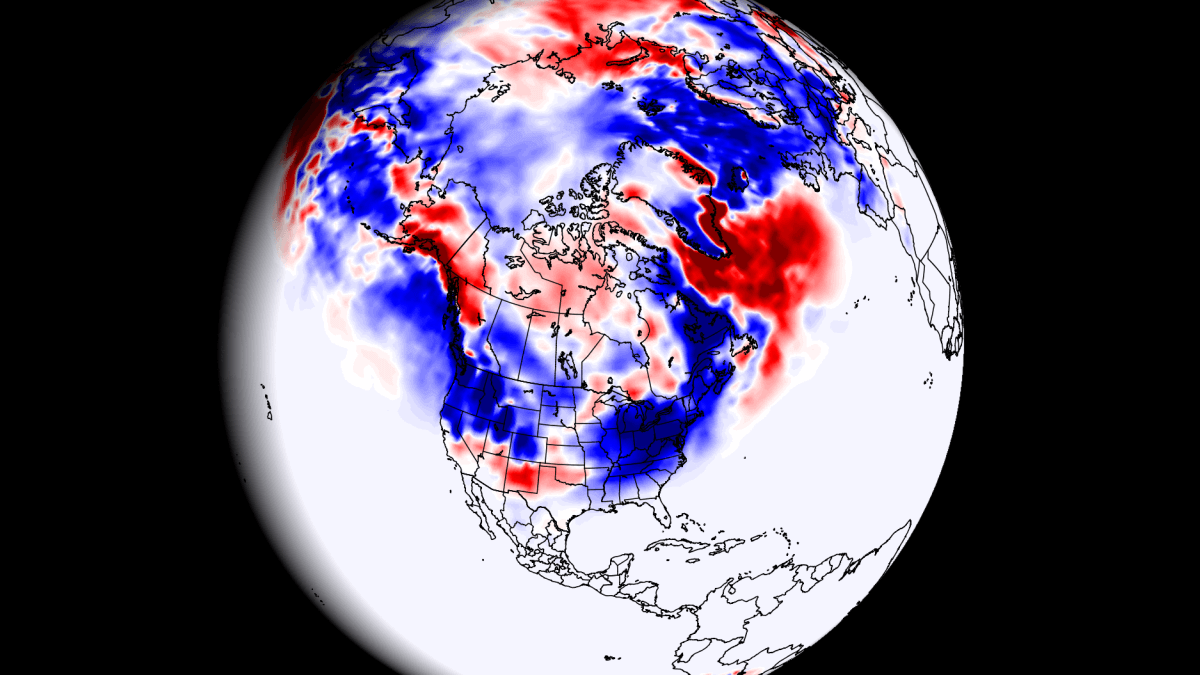
GLOBAL SEASONAL WEATHER INFLUENCE
ENSO is a region of the equatorial Pacific Ocean that changes between warm and cold phases. Typically there is a phase change around every 1-3 years.
The cold phase is called La Nina, and the warm phase is called El Nino. We are currently in a La Nina phase, entering its 3rd year, which will also be its final season for some time.
ENSO phases significantly influence tropical rainfall, pressure patterns, and the complex exchange between the ocean and the atmosphere. The image below shows the circulation pattern of a cold phase and its ocean-atmosphere connection.
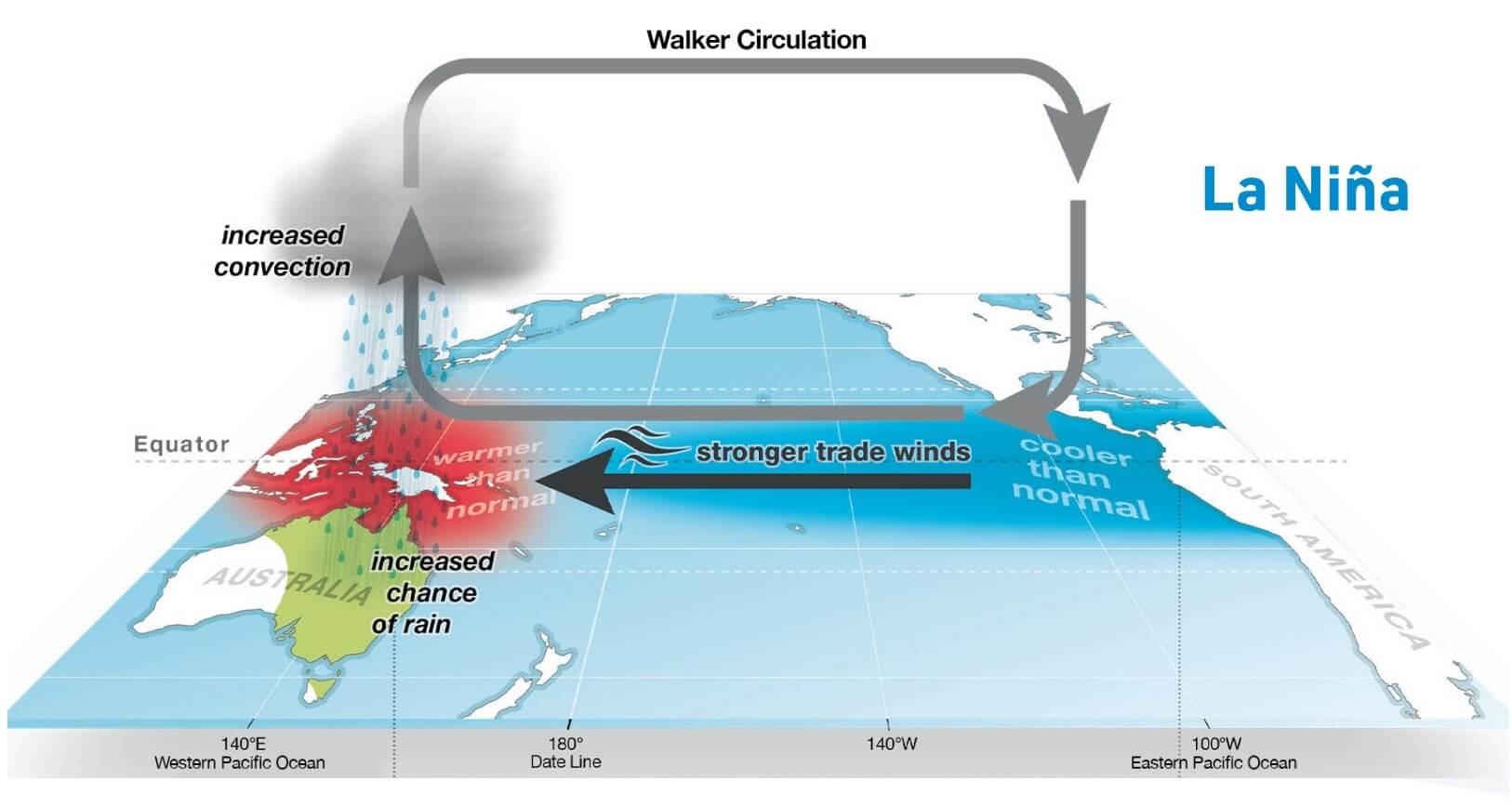
This way, the ENSO significantly impacts tropical rainfall and pressure patterns, altering the atmosphere-ocean feedback system. The ENSO influence is spread globally through this feedback system, changing the Winter temperature and snowfall patterns.
Below we have the latest surface analysis of the tropical Pacific Ocean. Cold ocean anomalies extend across most of the tropical Pacific. This currently active La Nina is forecast to reach its peak strength this month.
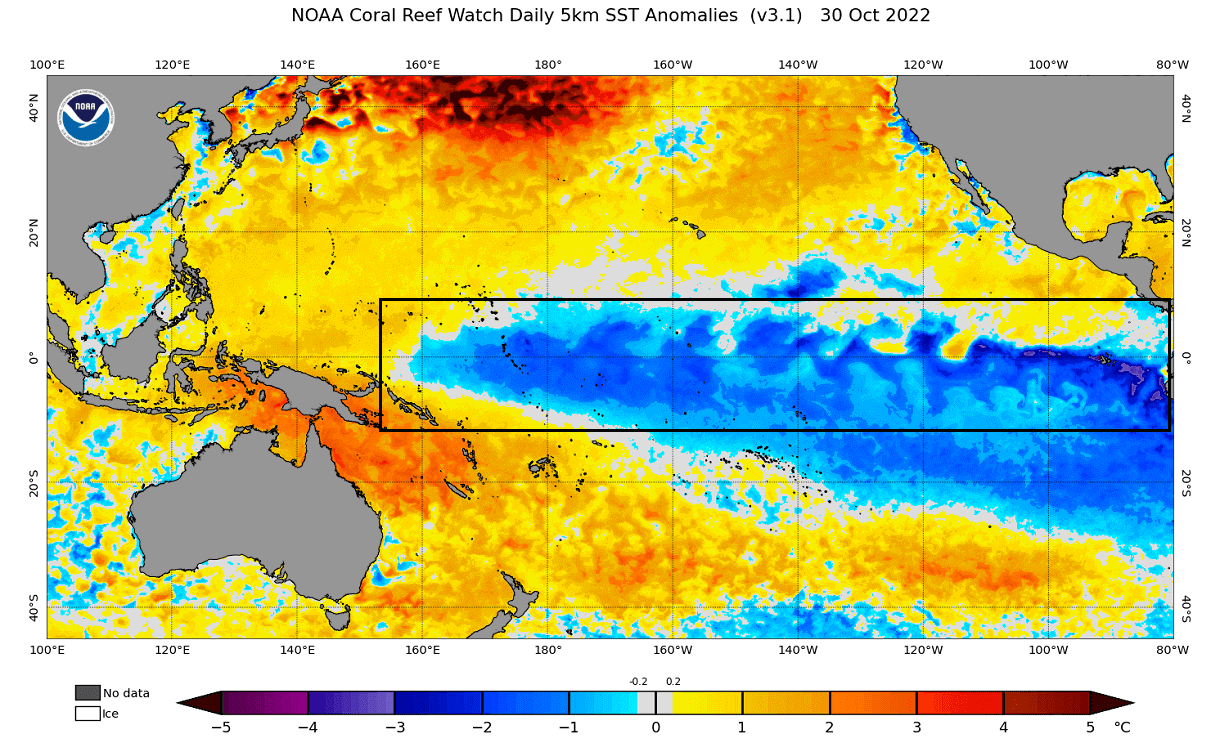
La Nina usually forms during strong trade winds, which can tell us much about the state of global circulation. This way, we can use these anomalies as an “indicator” to better understand the current state of the global climate system.
Below, you can see the progress of some historical multi-year La Nina episodes, with only two events previously having a 3rd-year event. Three events went neutral in the third year, and three phases reversed into an El Nino in the third season.
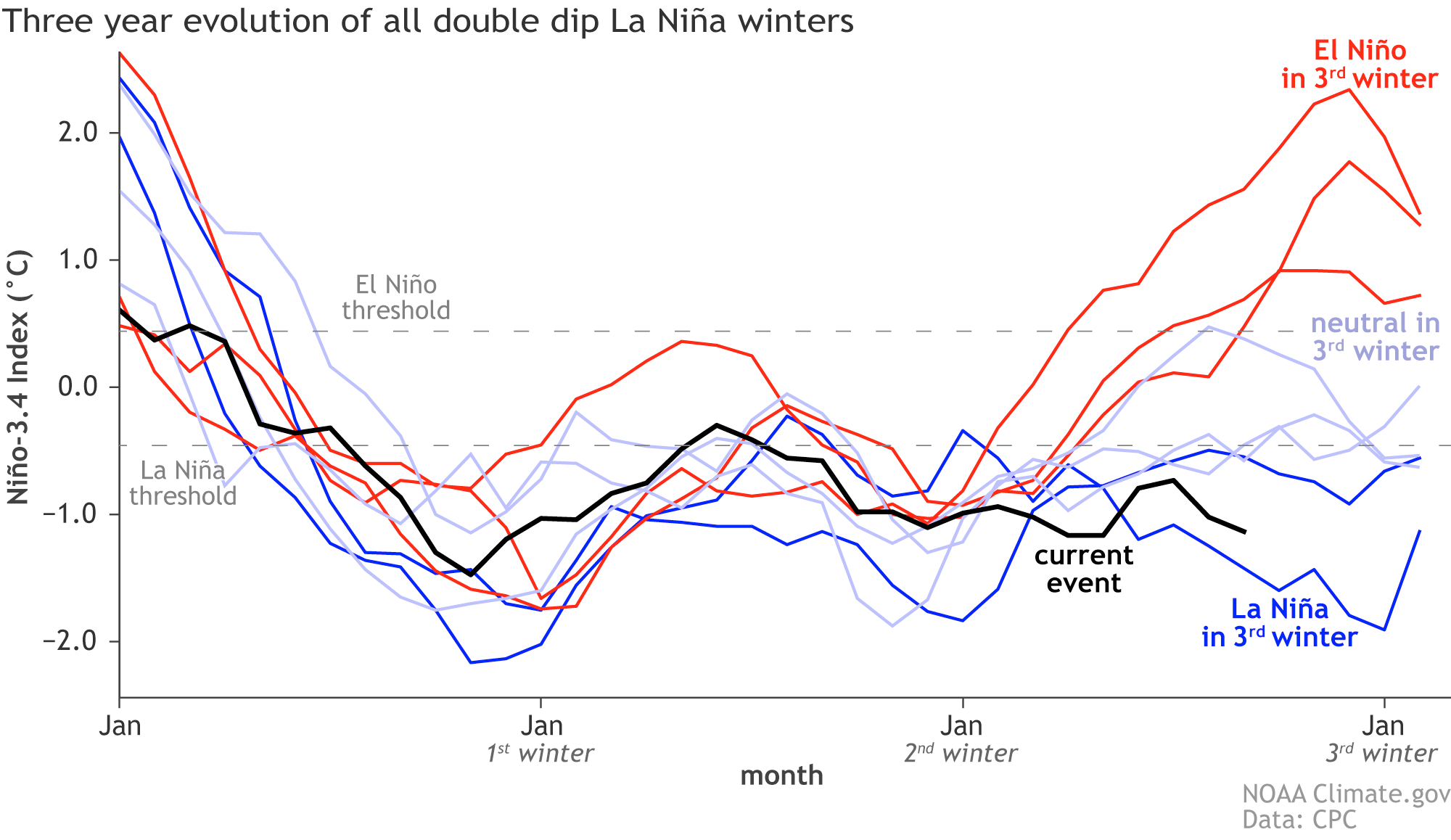 No cold event has gone into the 4th year, so it is expected that we will see the last La Nina phase this season for a while.
No cold event has gone into the 4th year, so it is expected that we will see the last La Nina phase this season for a while.
ENSO WINTER FORECAST
Below we have an Official NOAA CPC probability forecast graphic, which shows the long-range forecast of the central ENSO region. As forecasted, the La Nina conditions will last over the Fall and Winter. The La Nina will weaken early next year, with a neutral phase lasting into summer.
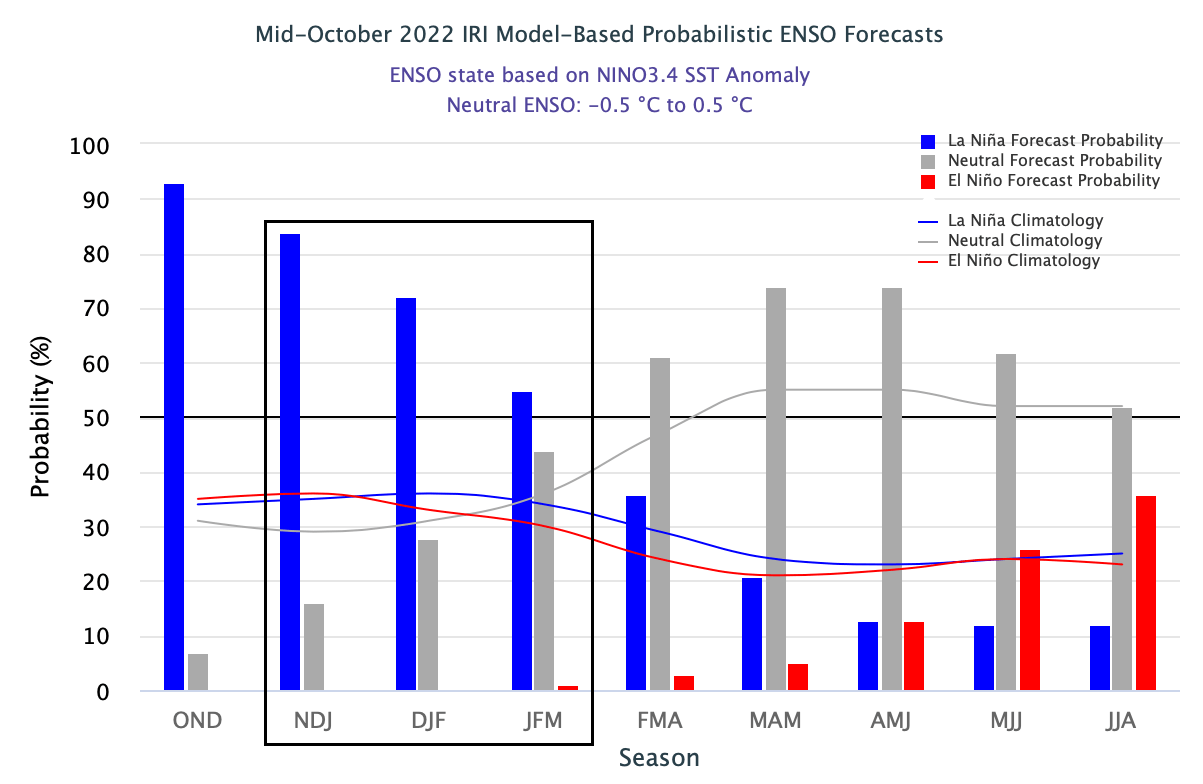
To better understand the ENSO changes, we produced a video showing the La Nina anomalies from Summer into Fall.
The video below shows the developing cold ocean anomalies in the equatorial Pacific as we head deeper into Fall.
So what exactly does this mean for the winter weather patterns and snowfall potential? We will take a closer look at the weather influence that La Nina usually shows over North America, as there it has a more direct impact.
Europe is not known to have any specific/direct influences, as it is too far from the source. But that does not mean it has no impact.
La Nina does change the weather globally, but apart from the direct influence over North America, places like Europe have many other factors at play before any La Nina influence can spread this far.
NORTH AMERICA WINTER WEATHER PATTERN
Typically, the first influence of these ocean anomalies can be seen in the jet stream patterns changing. The jet stream is a large and powerful stream of air (wind) at around 8-11km (5-7mi) altitude.
Historically, a strong blocking high-pressure system in the North Pacific is the most typical effect of a cold ENSO phase. That usually redirects the polar jet stream down over the northern United States, along with the colder air.
You can see that jet stream redirection in the image below. The image shows the average jet stream position in La Nina winters and the resulting weather patterns developing over the United States and Canada.
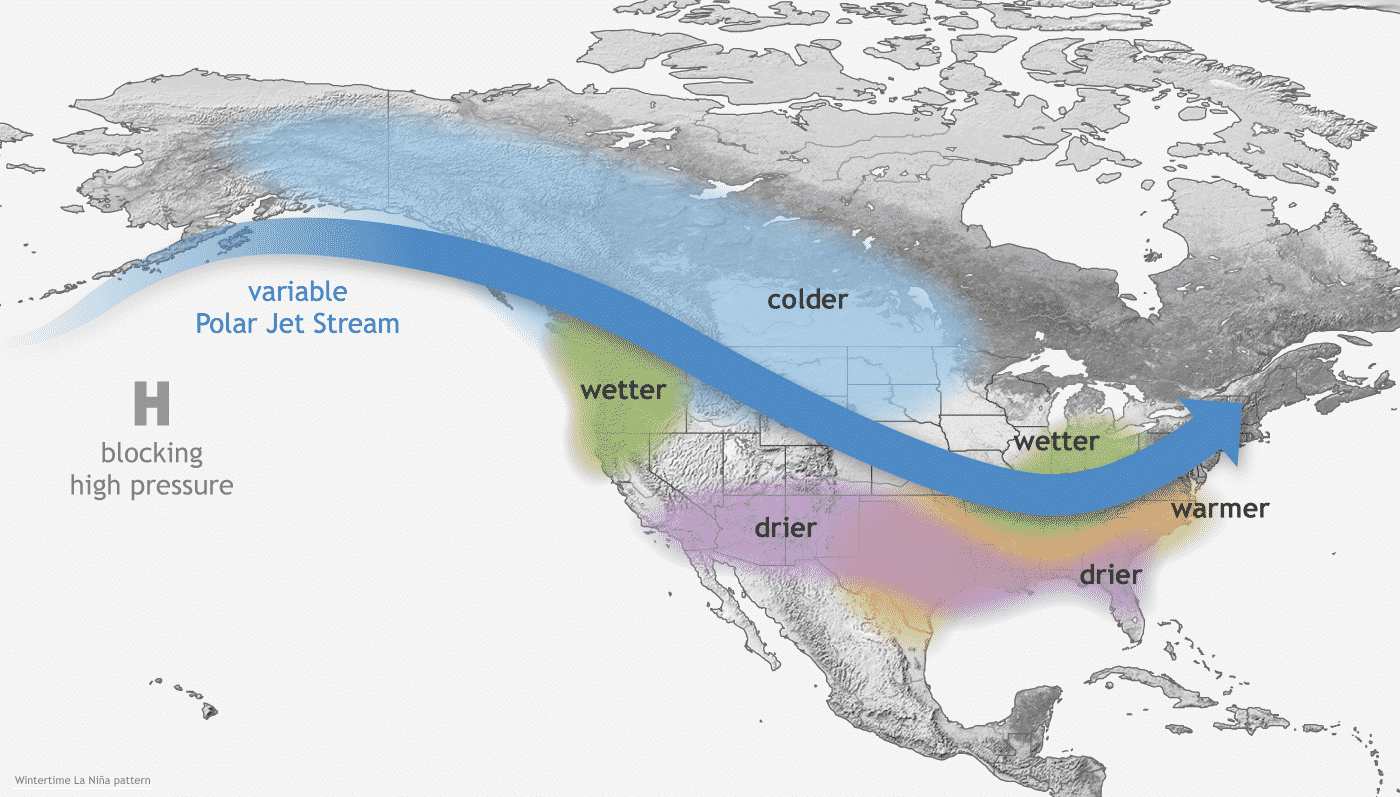
The displaced jet stream brings colder temperatures and winter storms from the polar regions down into the northern and northwestern United States. Warmer and drier winter weather prevails over the southern states.
The image below shows the average pressure pattern during the La Nina winters in the past 40 years. You can see a strong high-pressure system in the North Pacific and a low-pressure area over Canada and the northern United States. Images by NOAA PSL.
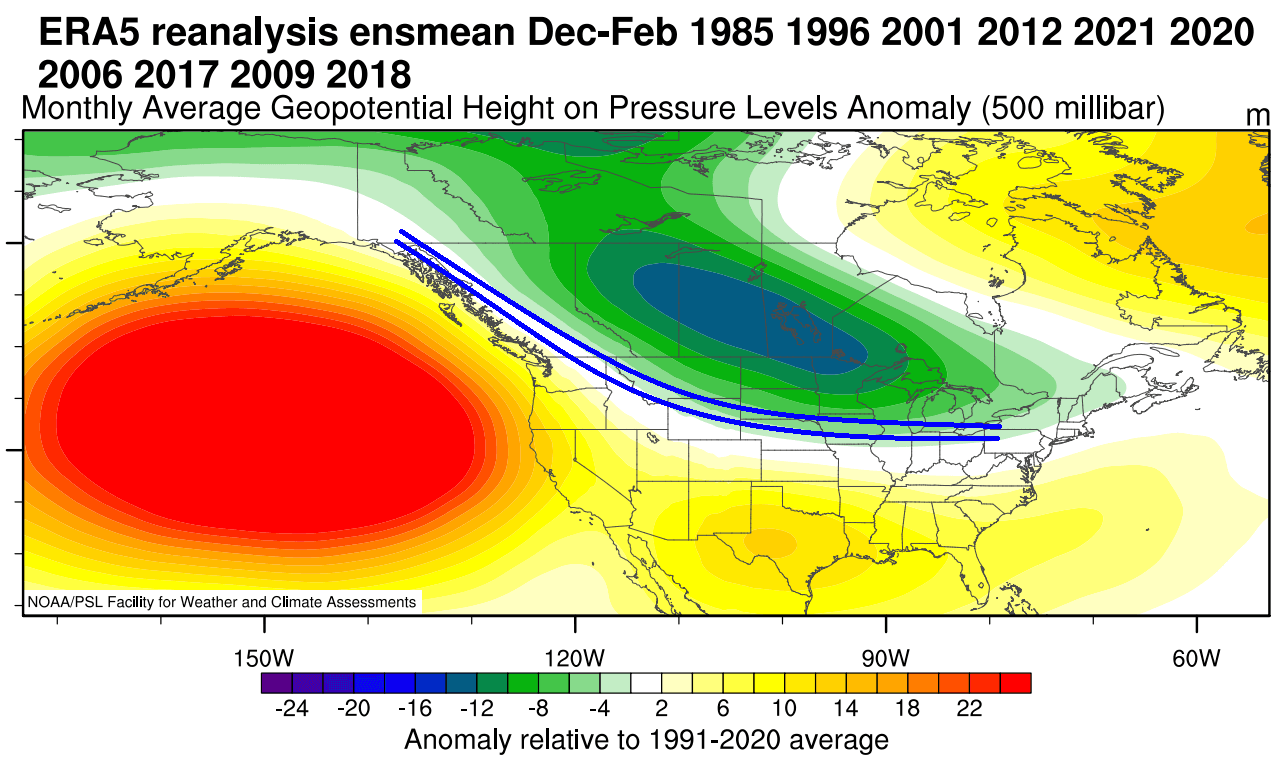
The circulation of the strong high-pressure system promotes the development of a low-pressure region over Alaska and western Canada. It relocates the jet stream downwards between the two strong pressure systems, marked above by the blue lines.
Looking at the temperature analysis for the same winters as above, we can see the cold anomaly area under the jet stream in western Canada and the northwestern United States. A cooler area extends over the Midwest and down into the south-central plains.
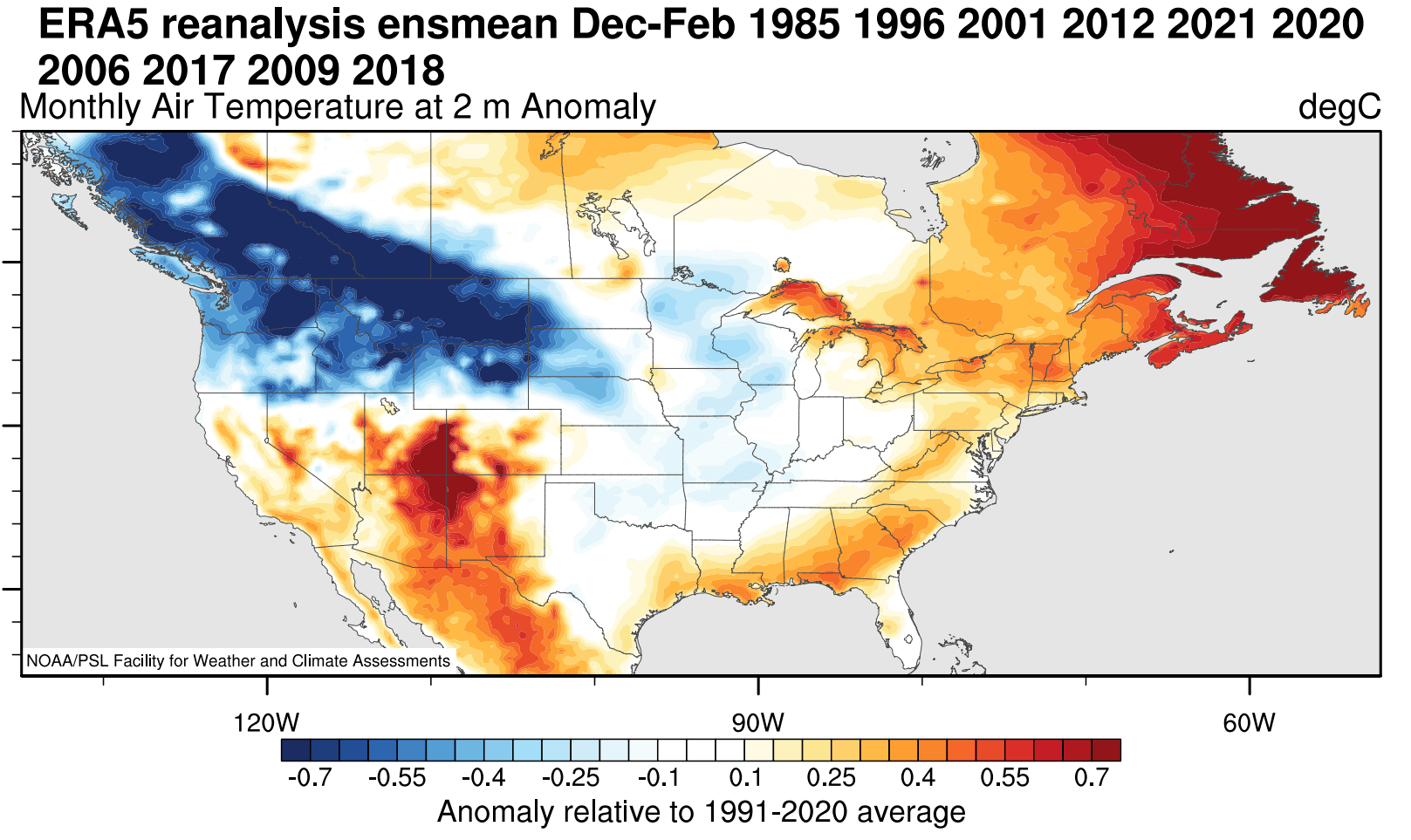
Warmer than normal weather and mild winter conditions typically develop over the southwestern United States, eastern United States, and eastern Canada. The most dynamic winter weather is usually found between the warm and cold anomalies in the Midwest and the central United States.
Looking at precipitation, La Nina winters are usually drier over the southwestern United States and Canada. Drier conditions also develop in the southeastern United States as La Nina produces a weaker subtropical jet stream and less moisture for the east. More precipitation is expected over the northwestern United States, the Great Lakes, and parts of the northeast.
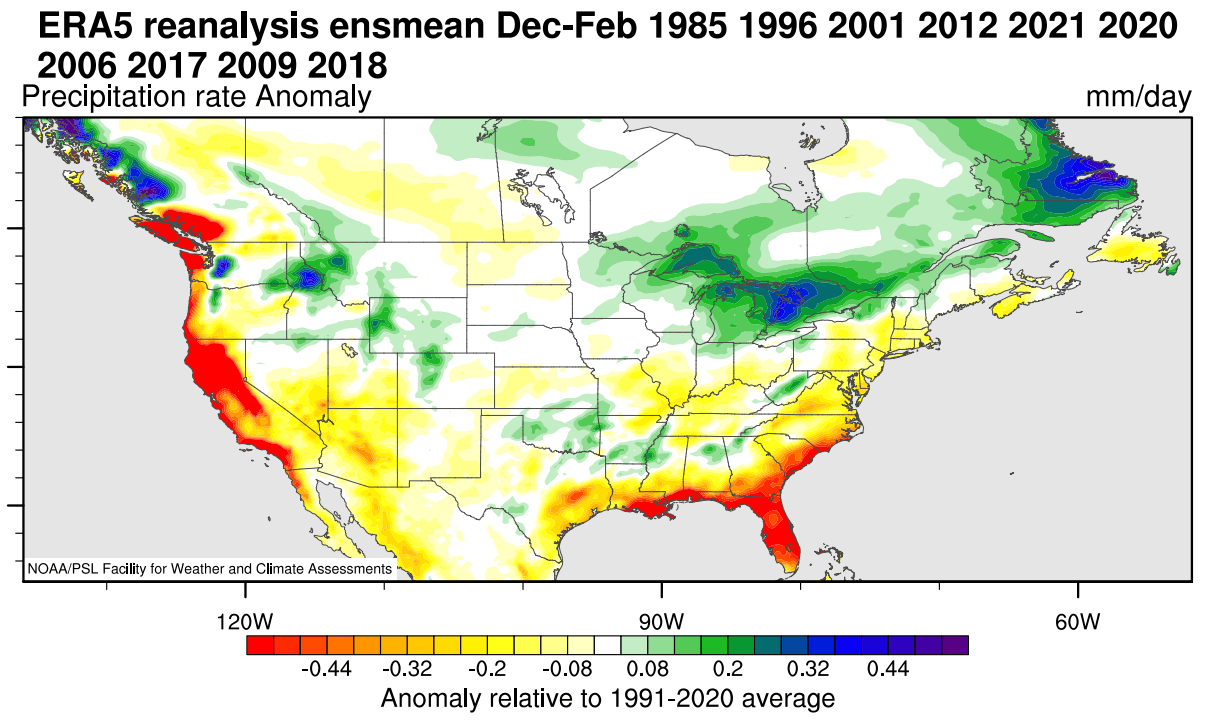
But what about snowfall? The data shows that the La Nina jet stream pattern also changes the snowfall potential over North America as the pressure systems take a different path, along with the cold air.
The colder air is more easily accessible to the northern United States, which increases the snowfall potential when moisture is available. In the graphic below by NOAA-Climate, you can see the average snowfall pattern for weak La Nina years, as expected for this Winter season.
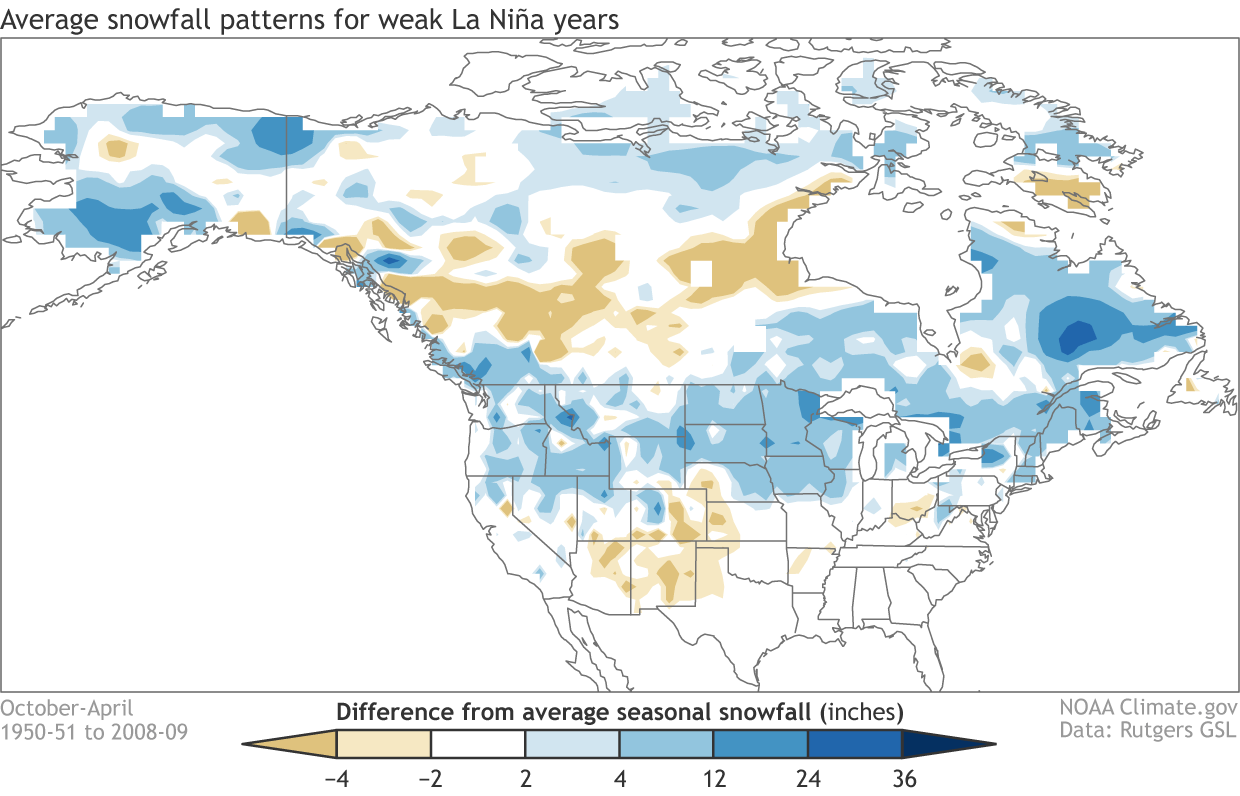
Besides the northwestern United States and the Midwest, we can see more snowfall potential over the northeastern United States and eastern Canada.
But now, we will look at some actual Winter snowfall predictions from the latest forecast models. Since the latest forecast data was released in mid-late October, we now also have the March data included, so it is a full-Winter snowfall forecast.
WINTER 2022/2023 ECMWF/UKMO SNOWFALL PREDICTIONS
The format of this forecast is simple. We will look at two highly regarded seasonal weather forecasting systems. First is the ECMWF, and then it is the UKMO. The data used to produce these graphics is the latest available at the present time, from mid-October.
You will see the average snowfall forecast for the meteorological Winter season, covering the December-January-February period. We will then do a monthly breakdown, as there are a lot of details in the monthly forecast that the whole seasonal average does not show.
ECMWF WINTER 2022/2023 SNOWFALL LATEST FORECAST
As always, we start with the ECMWF, the most often used and highly regarded seasonal forecasting system. ECMWF data provided is provided by the Copernicus-EU project.
Starting with the seasonal average, we see below-average snowfall over Europe, which is surprising given the lack of strong warm anomalies and normal precipitation. An increased snowfall potential is forecast over small parts of central Europe.
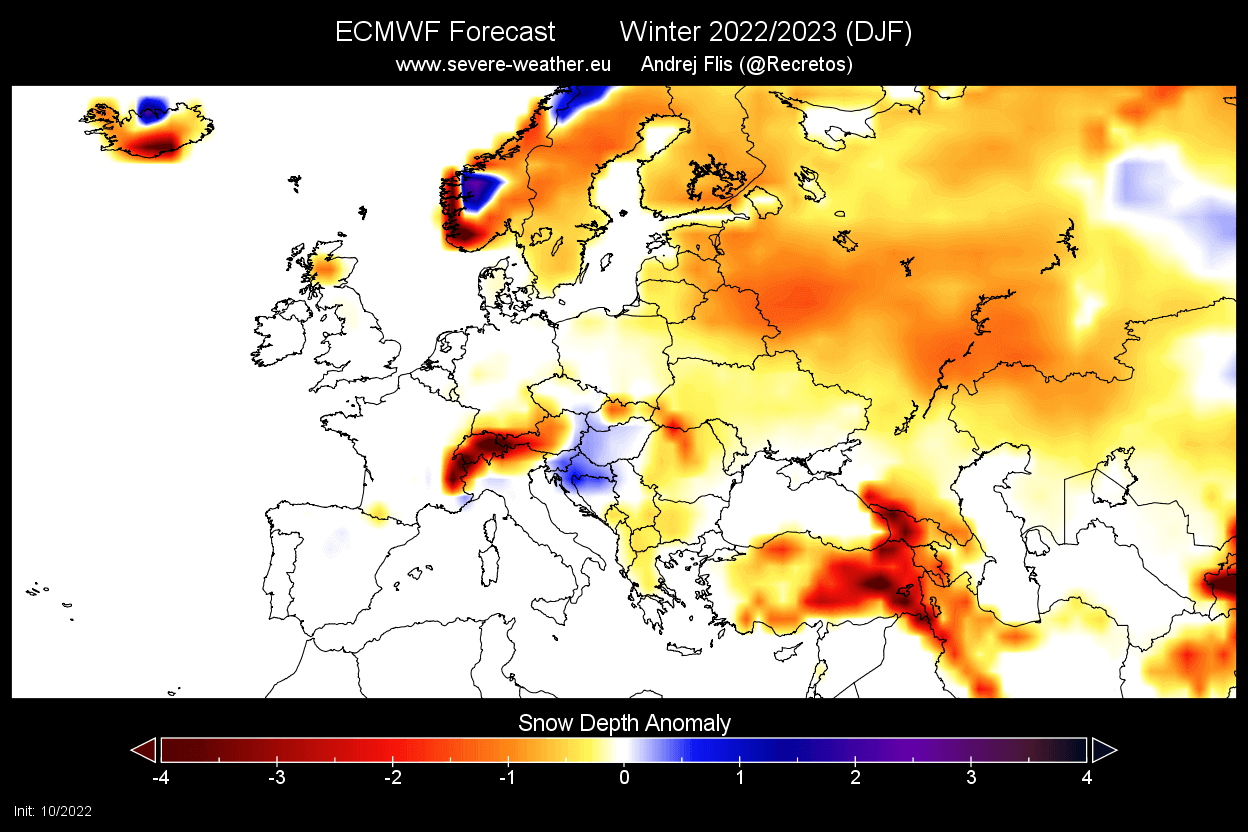
The December snowfall forecast shows strong negative anomalies. The pattern seems to be under the influence of a high-pressure system, as the forecast does not permit a lot of widespread snowfall scenarios and snow accumulation, except for central parts.
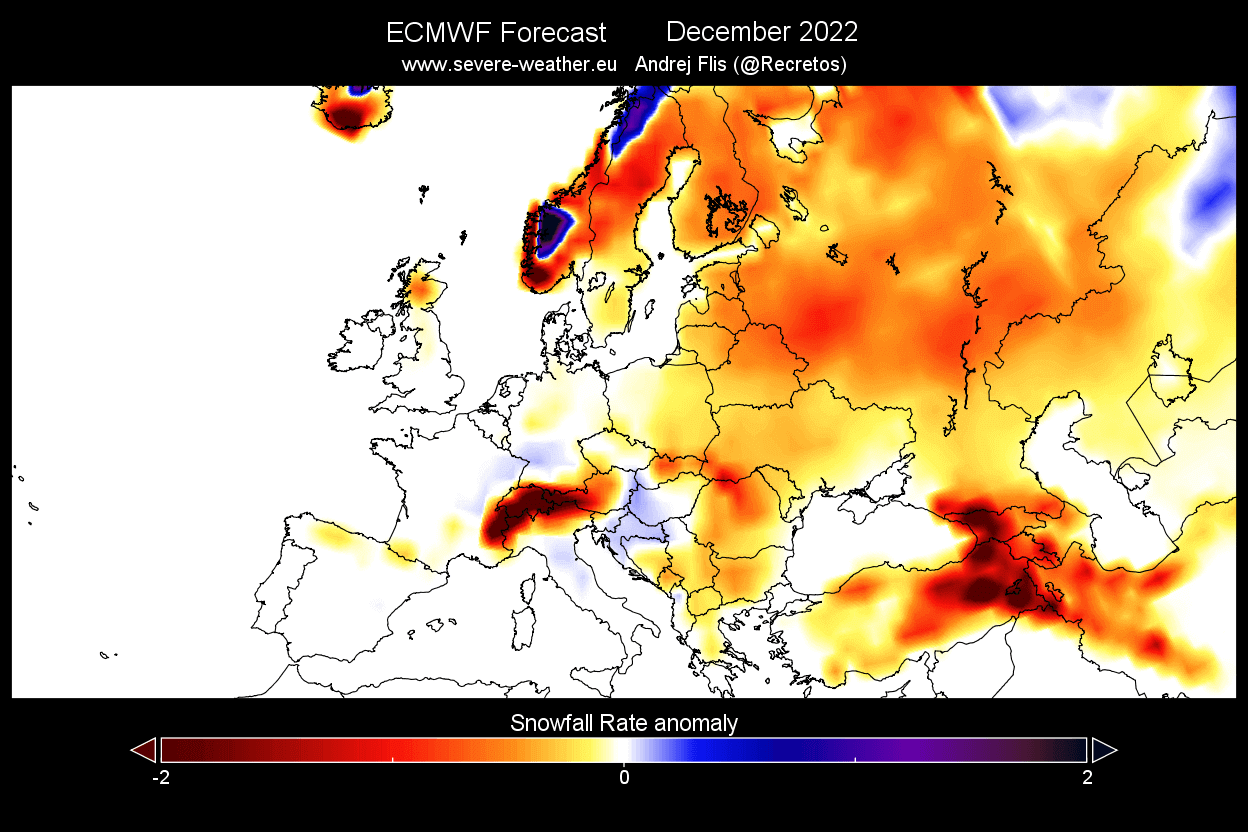
In the January forecast, there is a small improvement. Most of Europe is forecast to have less snow depth by mid-winter, but certain central and western Europe areas do show increased snowfall potential, more than in the previous calculations.
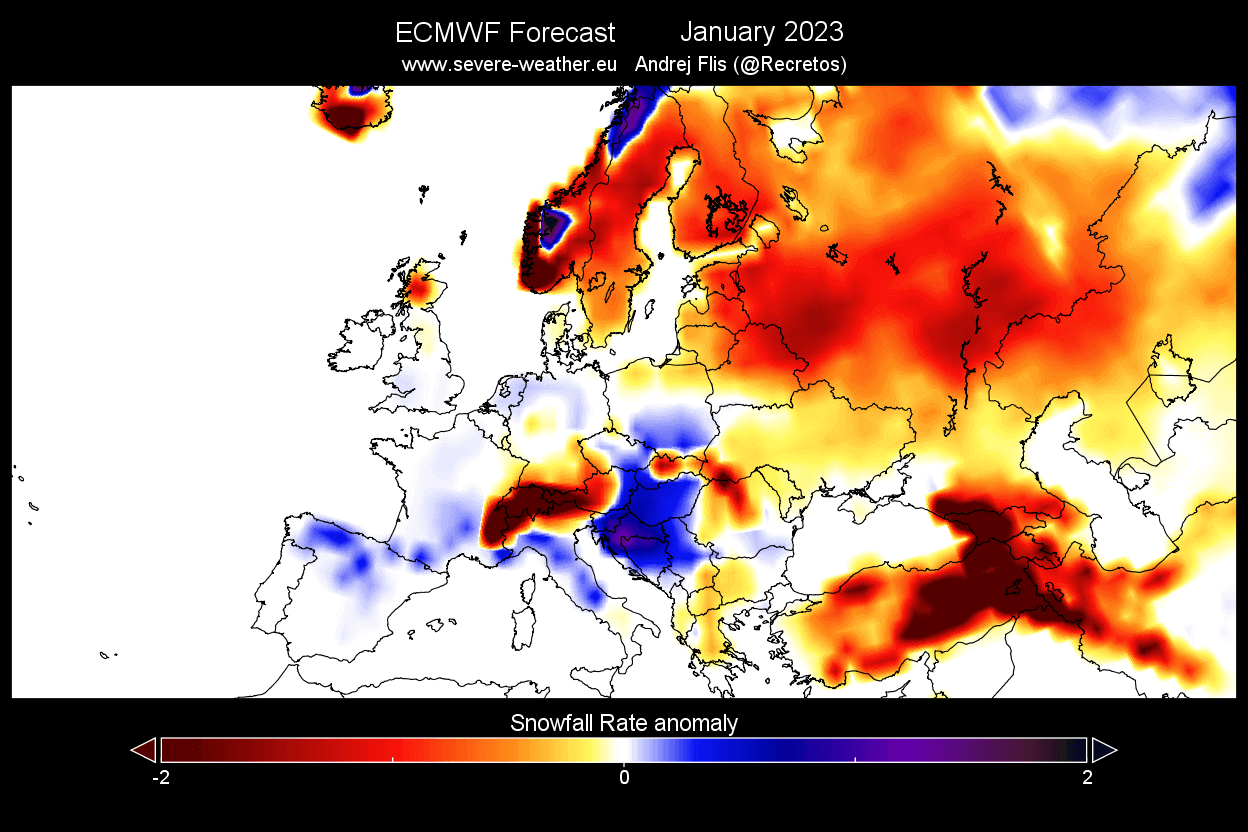
The February snow depth forecast shows the snowfall potential reducing again over most of Europe. The small regions south of the Alps are the only ones with more snowfall potential.
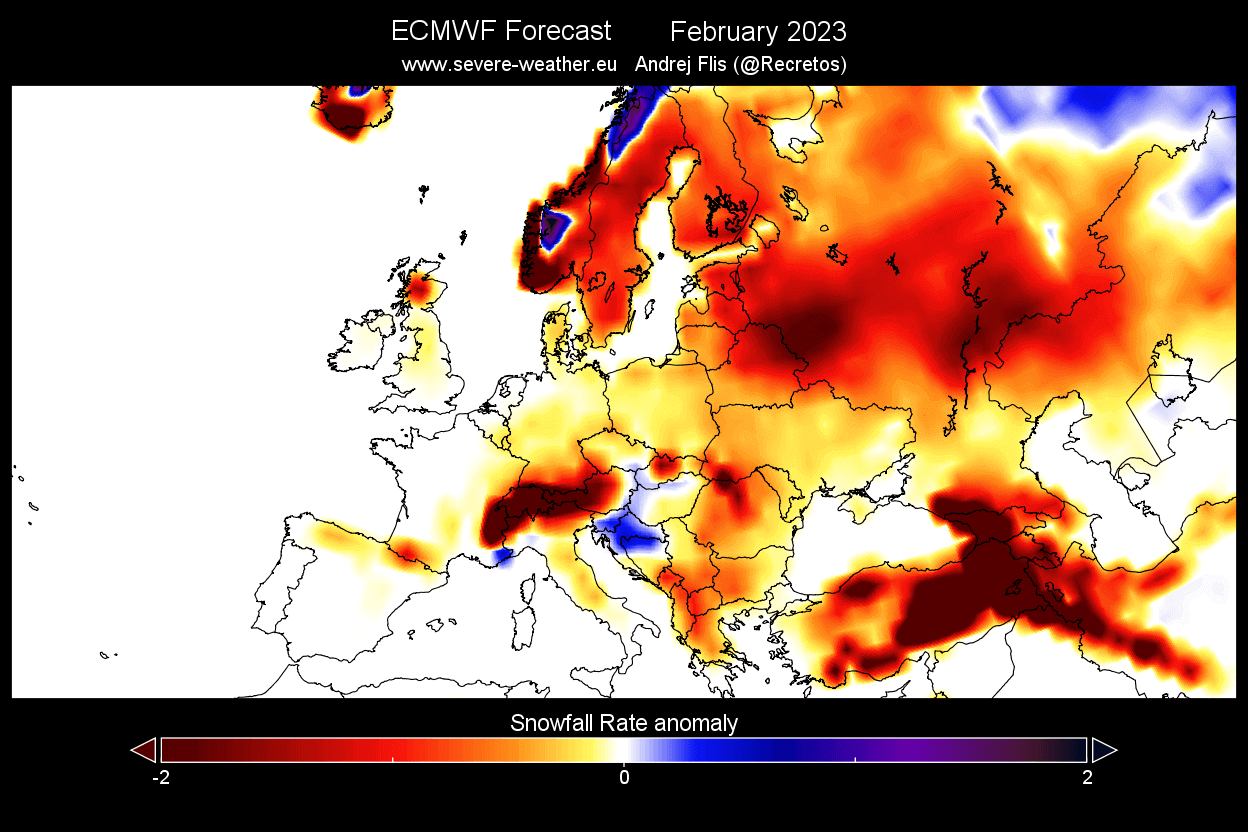
The next image below shows the change in the snow depth forecast between the latest model data and the previous model run. We can see that the latest ECMWF forecast shows more snowfall in central and western Europe compared to last month’s forecast for the entire Winter season.
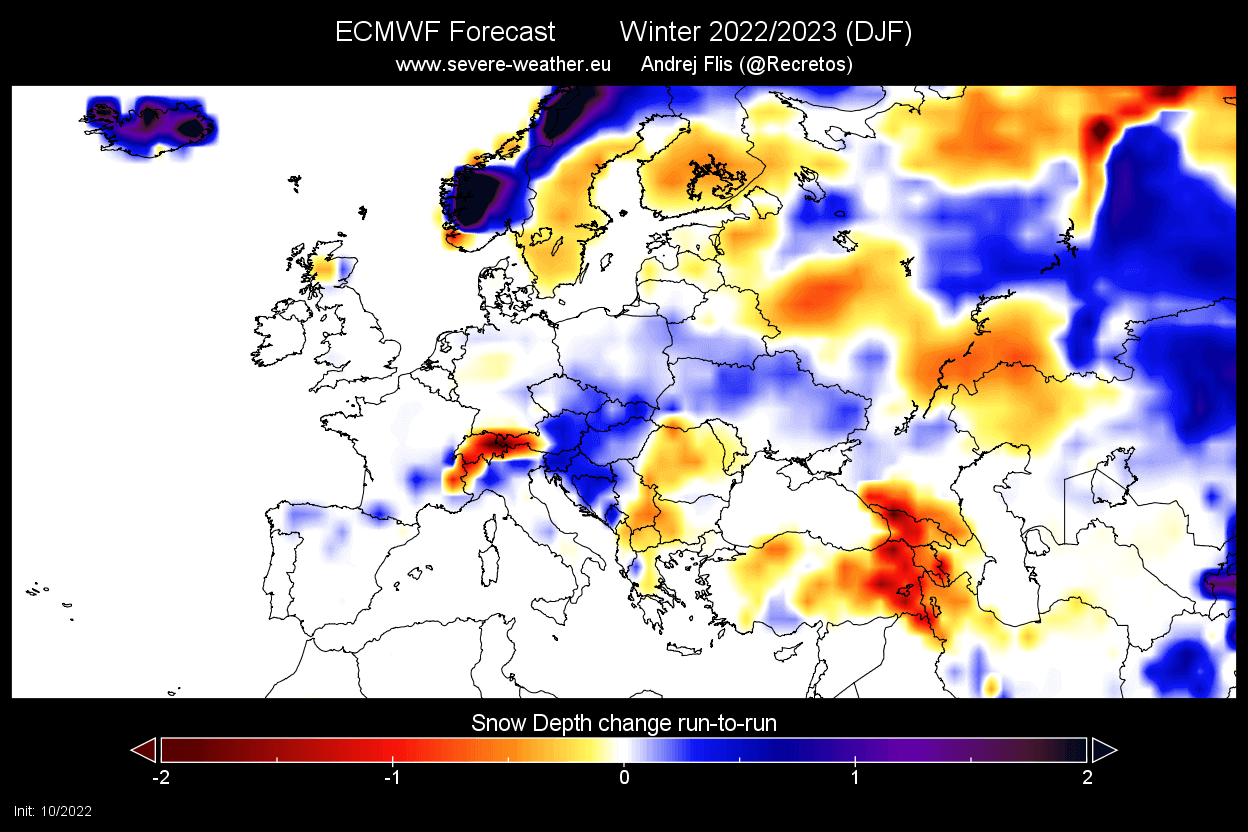
Also, for the first time, we have the March snowfall forecast data. Of course, March can still be cold and usually provides snowfall. But looking at the March snow forecast image below, we can see most of Europe having a lower-than-normal end to the snow season.
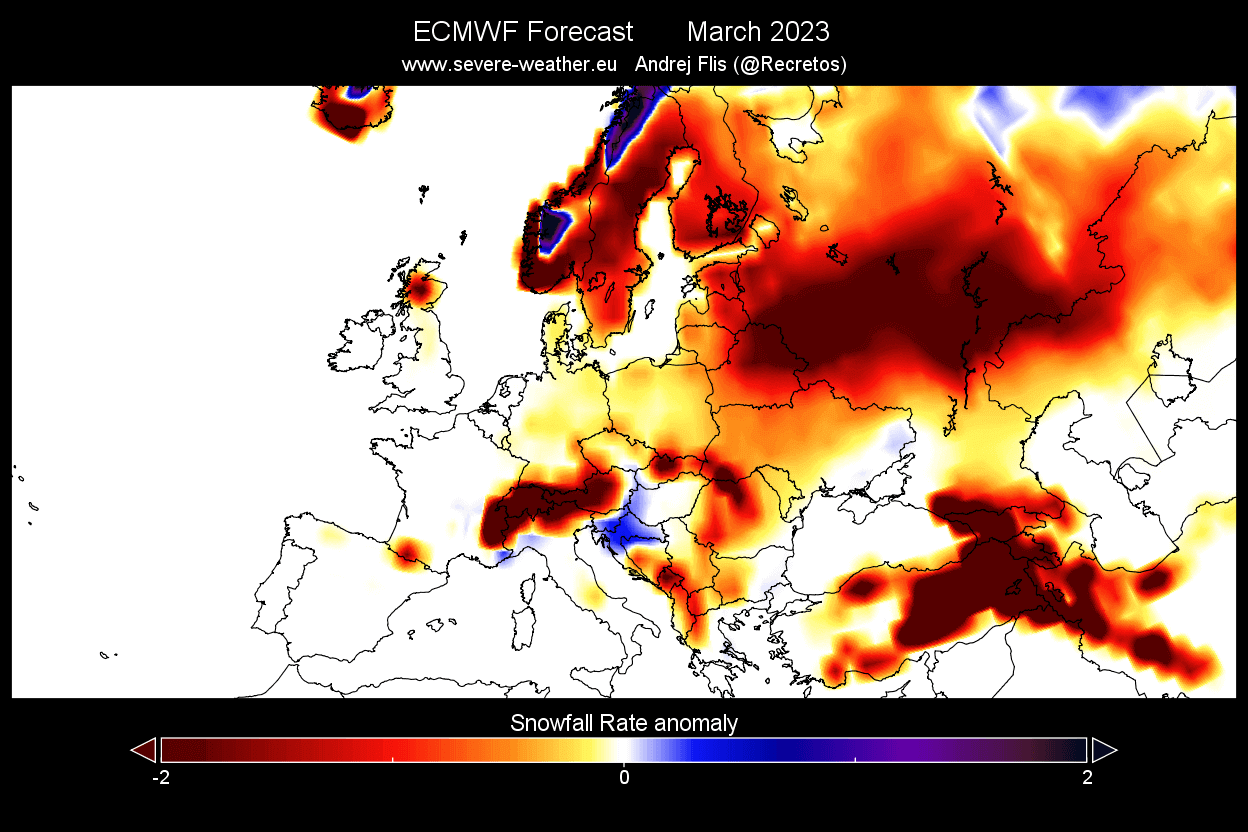
NORTH AMERICA ECMWF SNOWFALL PREDICTION
Over North America, most of the country has below-average snow accumulation, except for the northwestern United States, upper Midwest, and southwestern Canada.
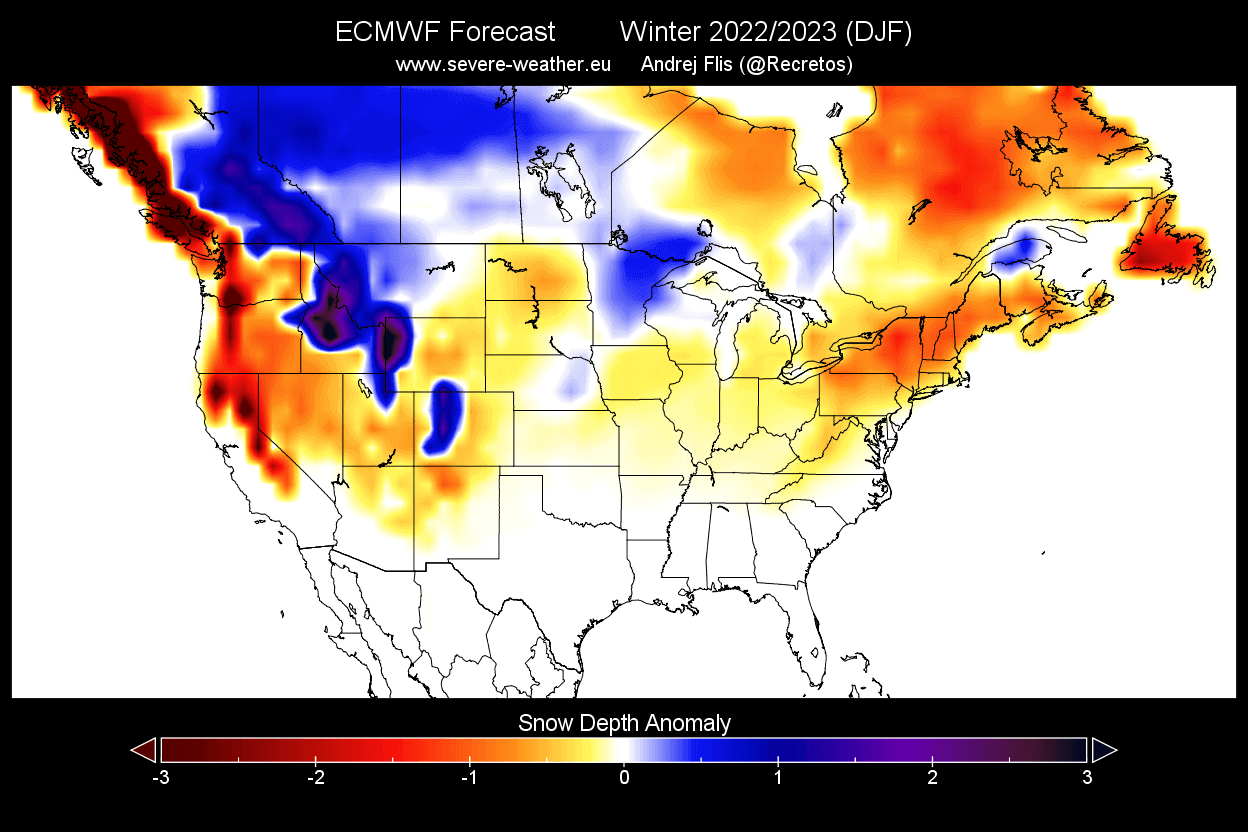
The December snow depth forecast shows less snow cover over most of the United States and Canada. One exception is southwestern Canada and higher elevations in the western United States. But note more snowfall potential over Minnesota and the south-central plains.
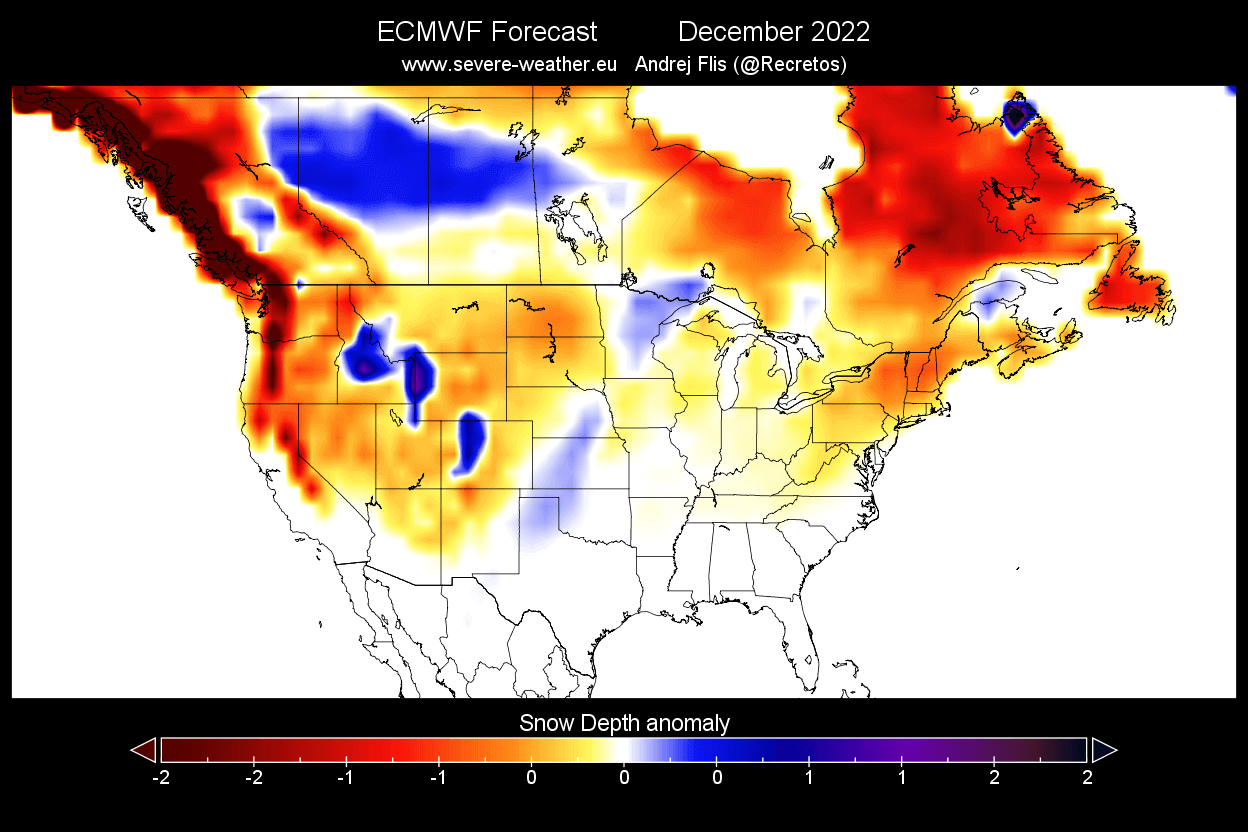
The January snow depth forecast shows more snowfall from western Canada into the northwestern United States. We see an increased snow potential over the upper Midwest, while the rest of the country seems to have less snowfall than normal in this month.
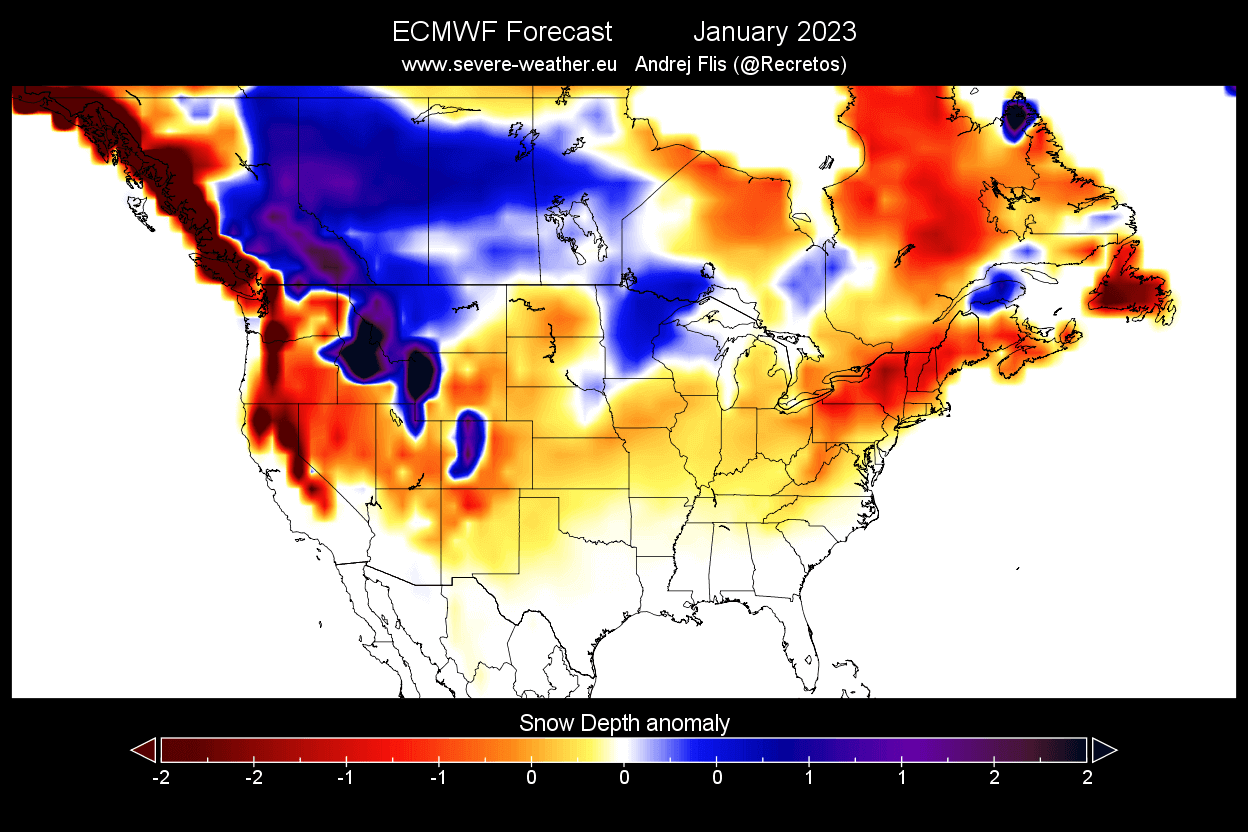
The February snow depth forecast shows continued increased snowfall potential over the northwestern United States and expanding over western and southern Canada. More snowfall is still forecast in the upper Midwest, with areas of more snowfall appearing over the central states.
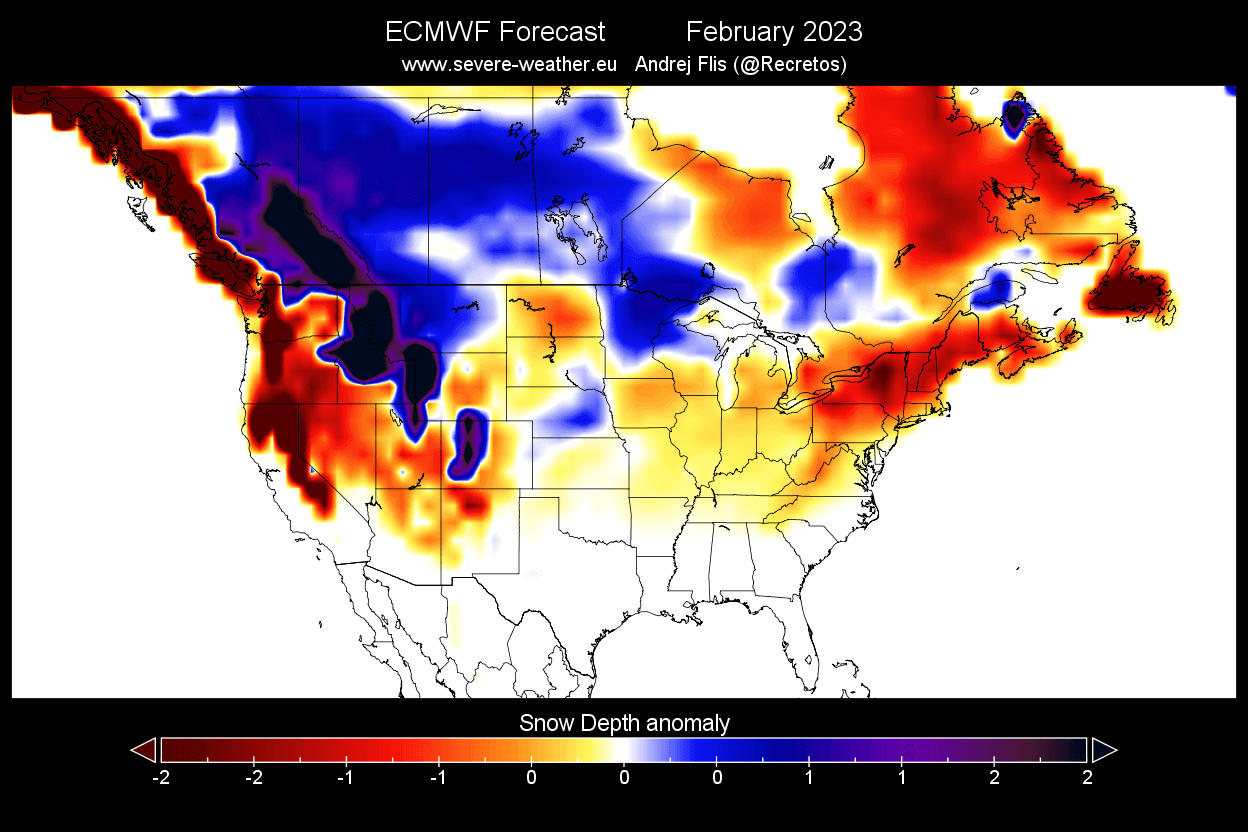
Below is an image that compares the latest forecast to the previous one. You can see that more snowfall is being forecast across much of the western and northern United States compared to the previous forecast. This is a reflection of the pressure changes in the latest model forecast.
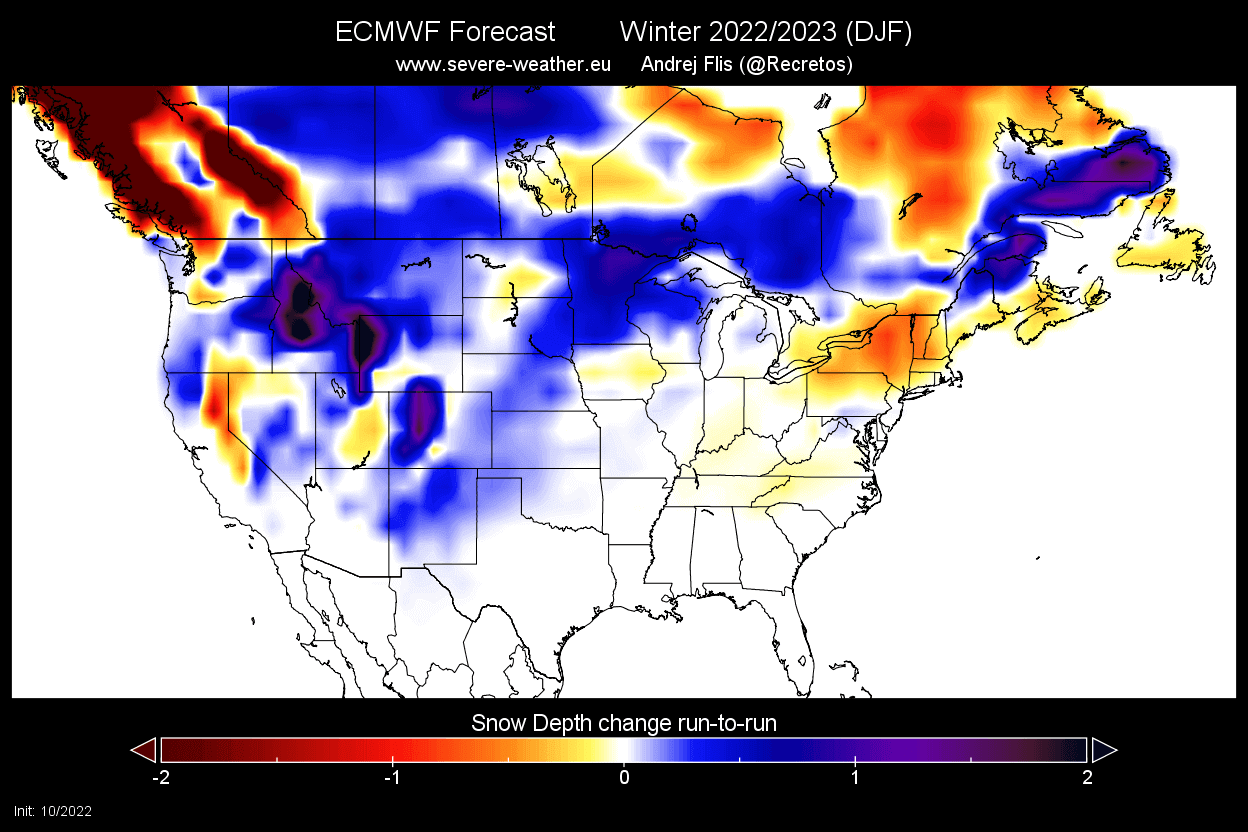
And we also have the March snow forecast data available for North America. Again, you can see more snowfall than normal covering a large area from western Canada down into the northwestern United States and the Midwest.
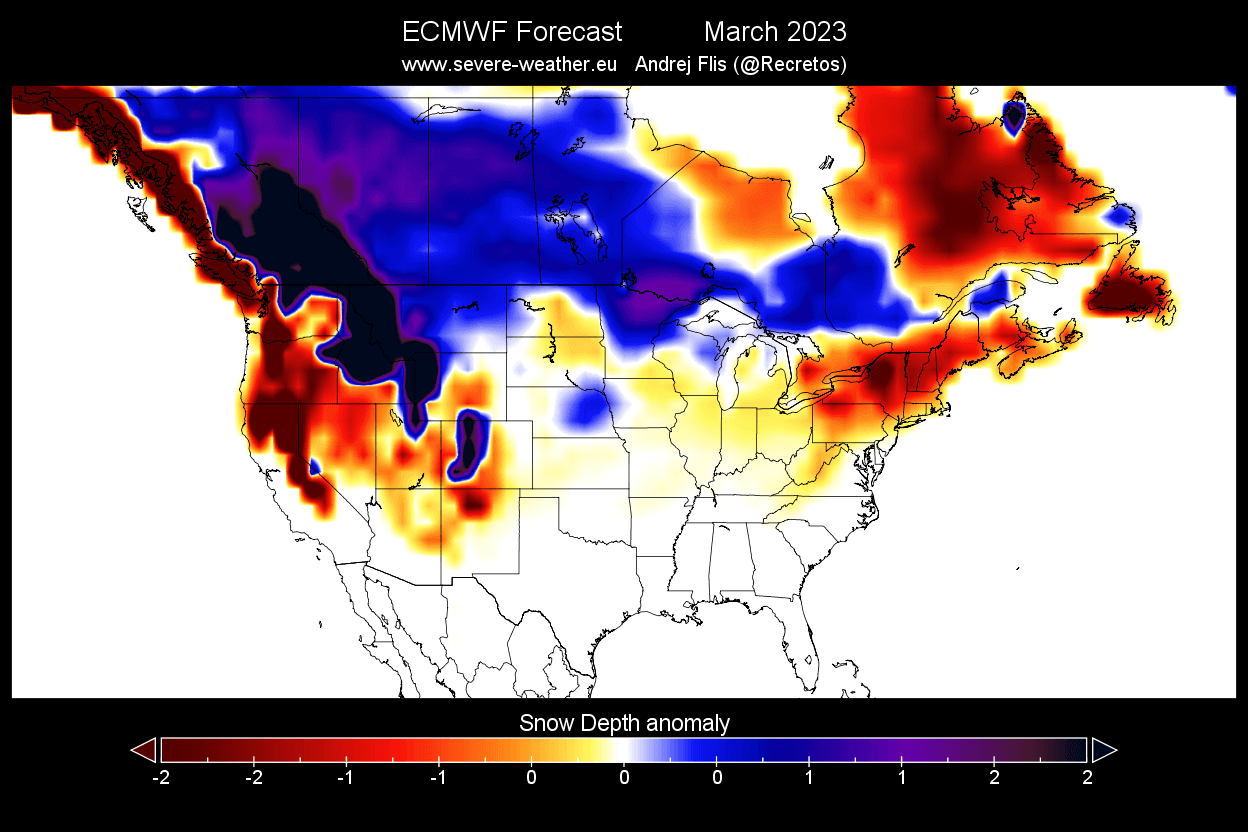
This implies the snow season continues strongly into March over the northern United States, courtesy of the La Nina season.
UKMO WINTER 2022/2023 SNOWFALL LATEST FORECAST
Long-range weather forecasting is tricky, as there are a lot of factors that impact seasonal climate. We are always only looking at trends and probabilities, but still, variation is key. The more forecast data you can look at, the better idea you can get about the expected weather.
As you can never trust a single forecast model, we always tend to use the UKMO long-range forecasting system along the ECMWF. It was developed by the United Kingdom Met Office, which is where the initials UKMO come from.
First, looking at the seasonal average for Europe, we can see another weak snowfall forecast similar to the ECMWF. Most of the continent is forecast to have less snowfall than normal, except for far northern Europe and western parts. UKMO uses a different parameter than the ECMWF but correlates directly with snowfall also.
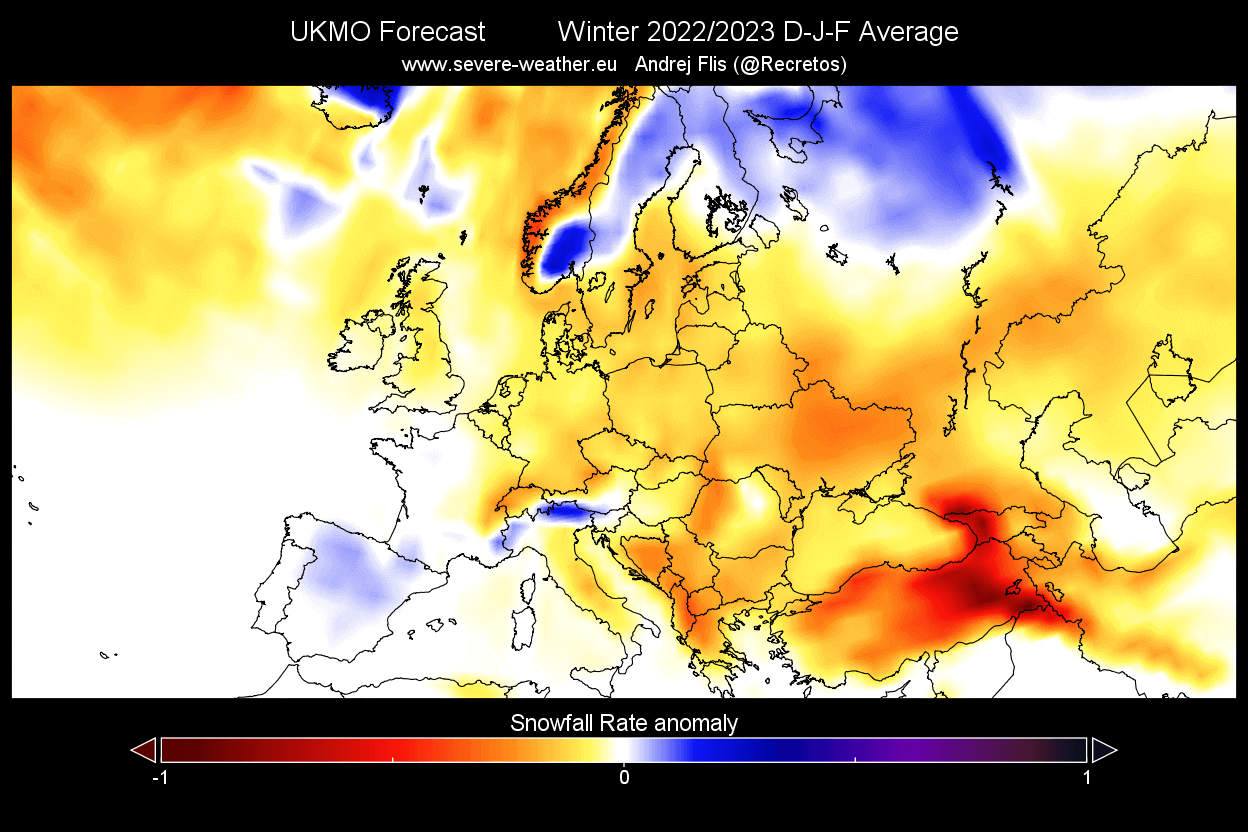
The December snowfall forecast shows some areas with more snowfall over northern, western, and central parts. The common agreement in both models s the increased snowfall in the central parts.
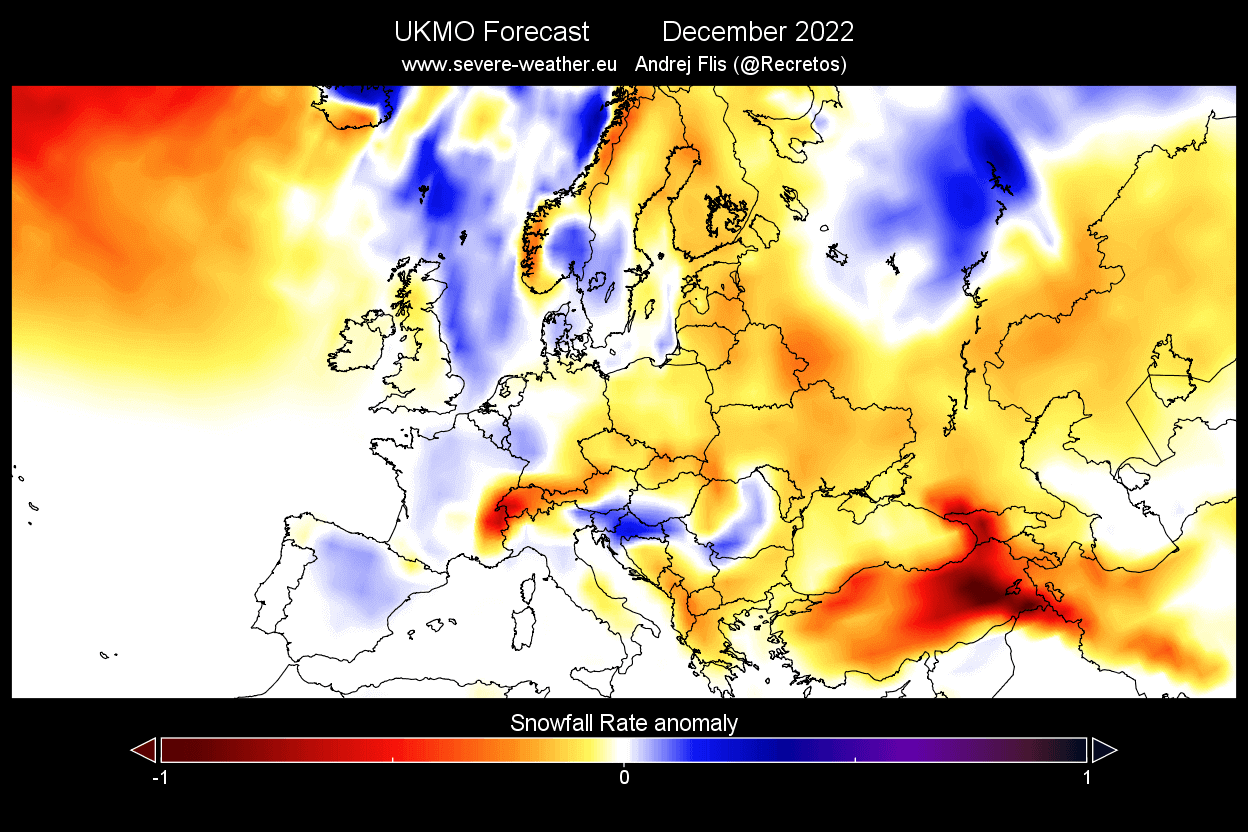
The January snowfall forecast shows more potential in northern and western Europe, similar to the ECMWF. More snowfall is also seen across the southern Alpine region.
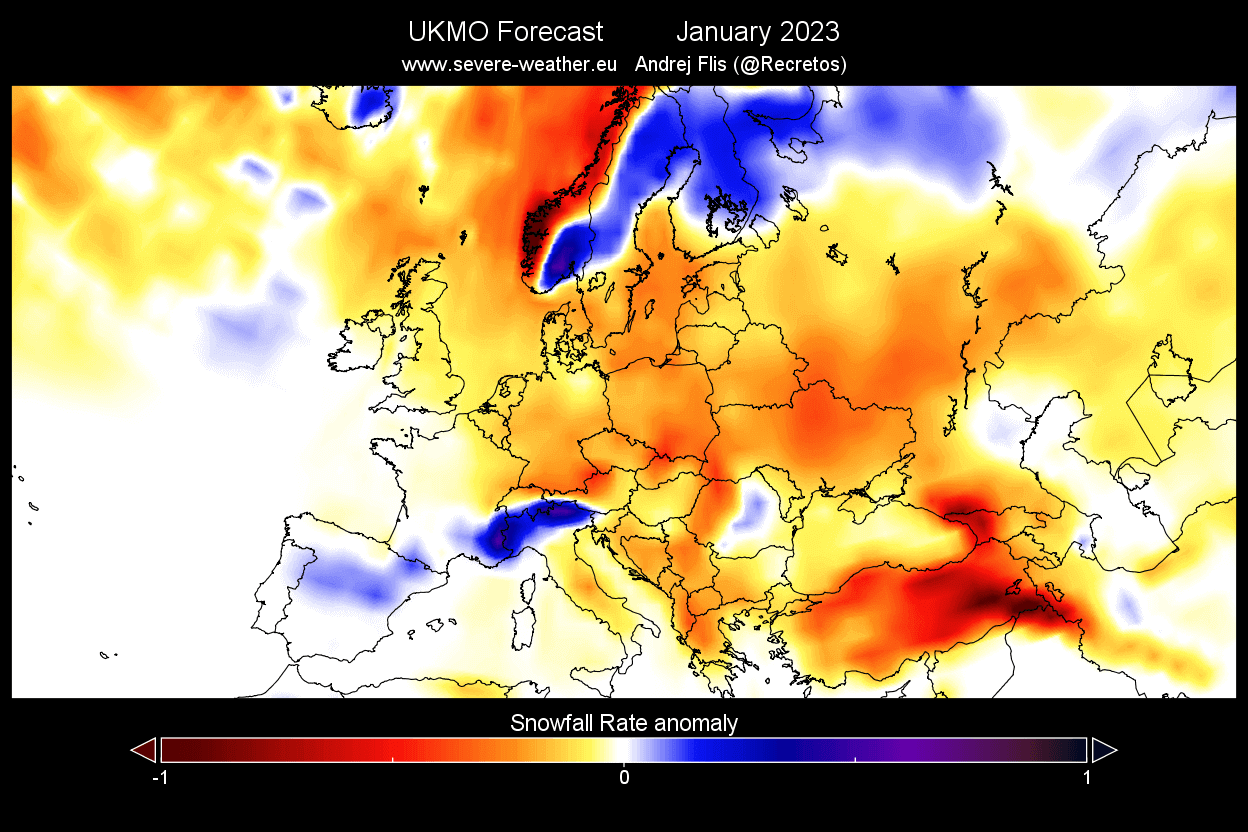
The February snowfall forecast indicates continued potential over the western parts of Europe. But otherwise, the rest of the continent shows less snowfall than normal for this month, expert further up over the north and over higher elevations.
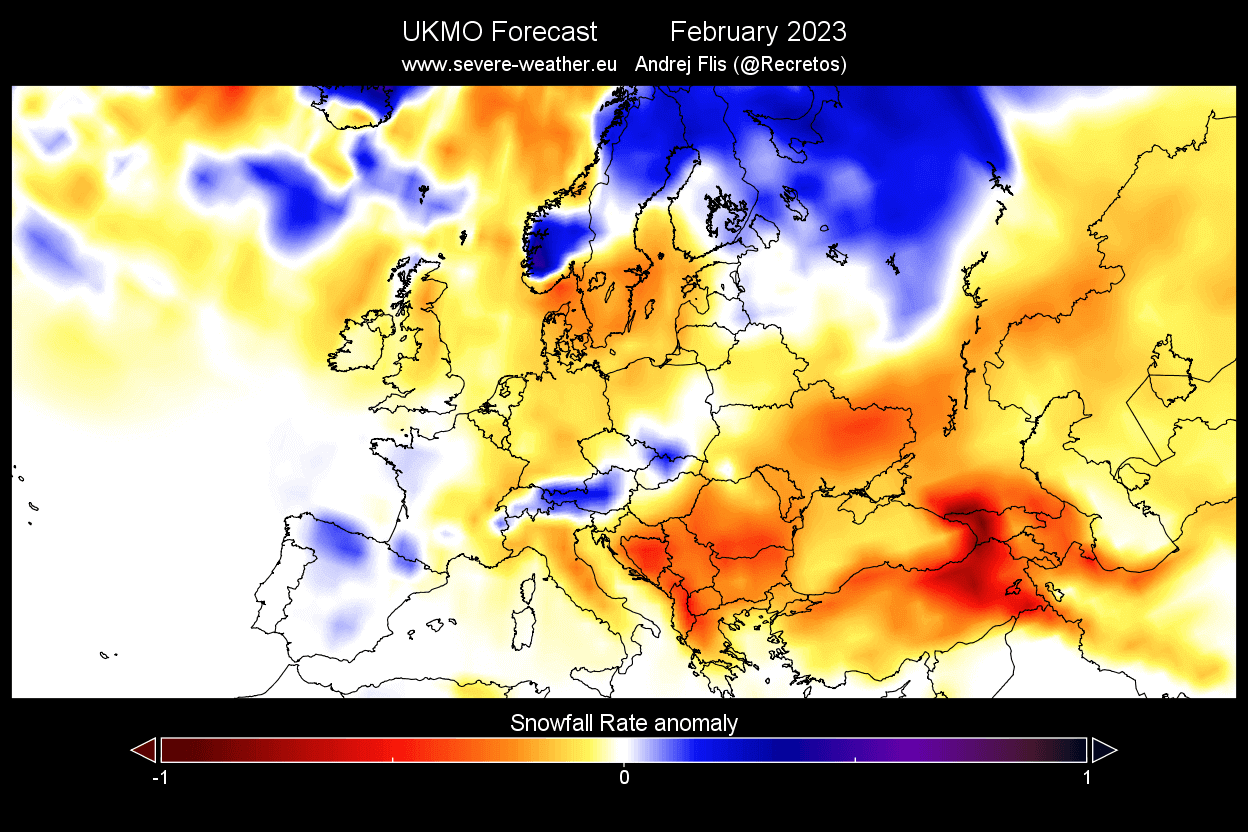
Looking at the overall average forecast and comparing it to the previous forecast, we can see that the latest run has more snowfall over most of Europe. It is still less than normal overall but shows more snowfall than the forecast issued last month.
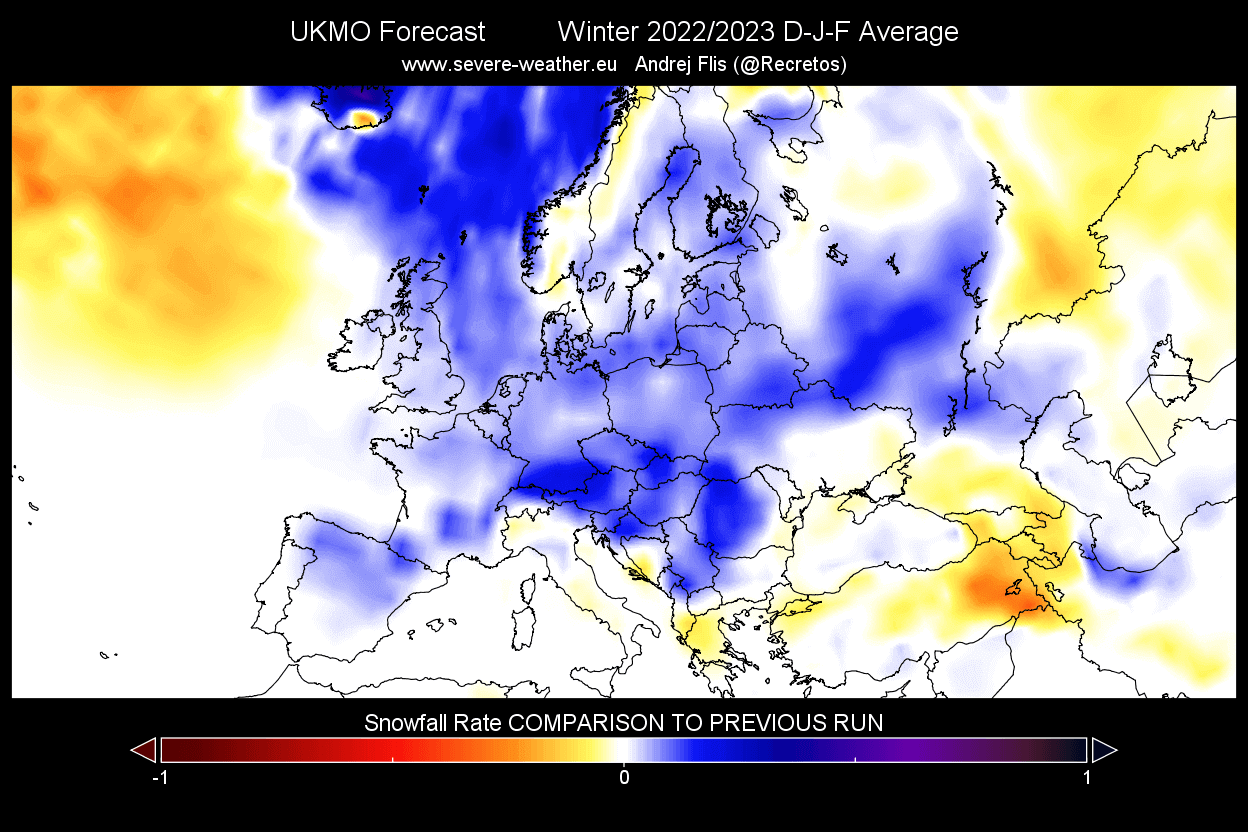
Also, the March forecast shows that the snowfall potential quickly diminishes over much of the continent.
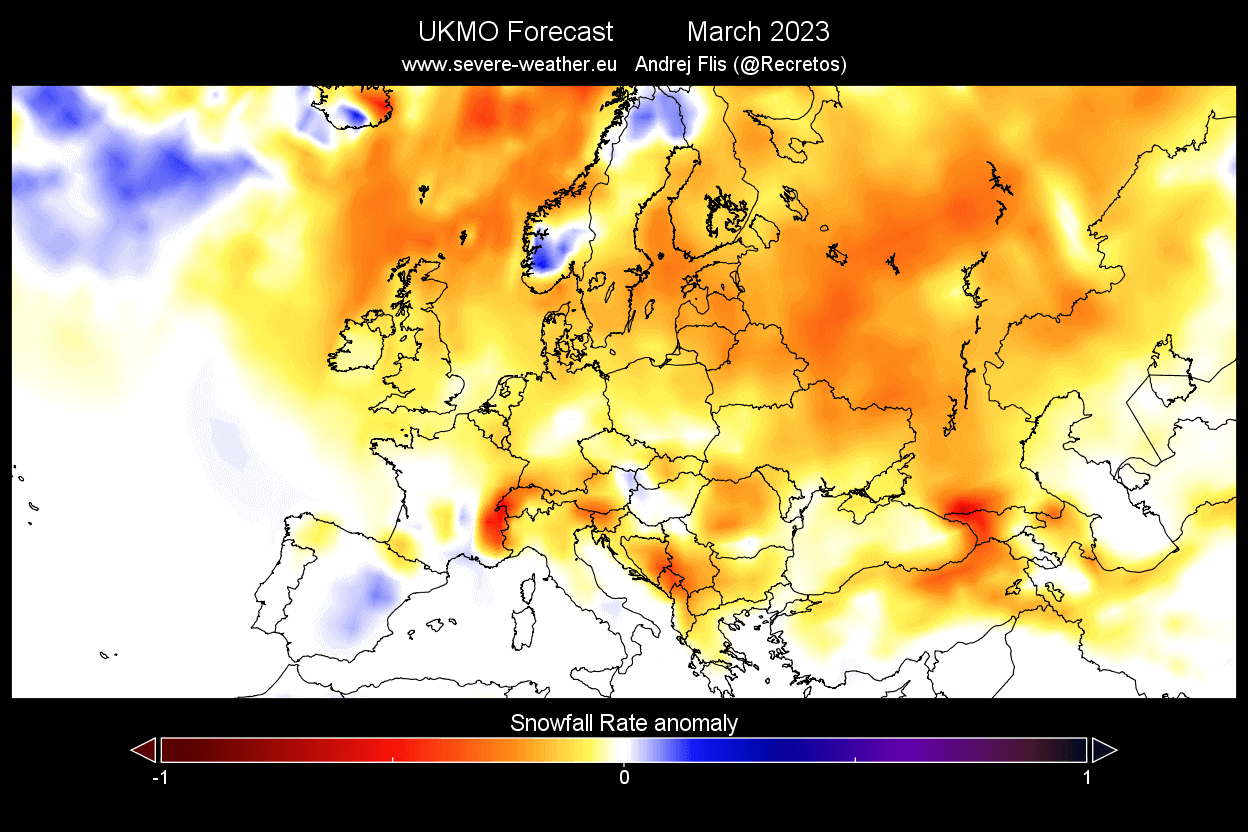
NORTH AMERICA UKMO SNOWFALL PREDICTIONS
The average seasonal forecast for the United States and Canada shows a typical La Nina snowfall pattern. We see more snowfall over the northwestern United States and the upper Midwest. This is not too far from the ECMWF prediction, but we also see more snowfall in the eastern United States.
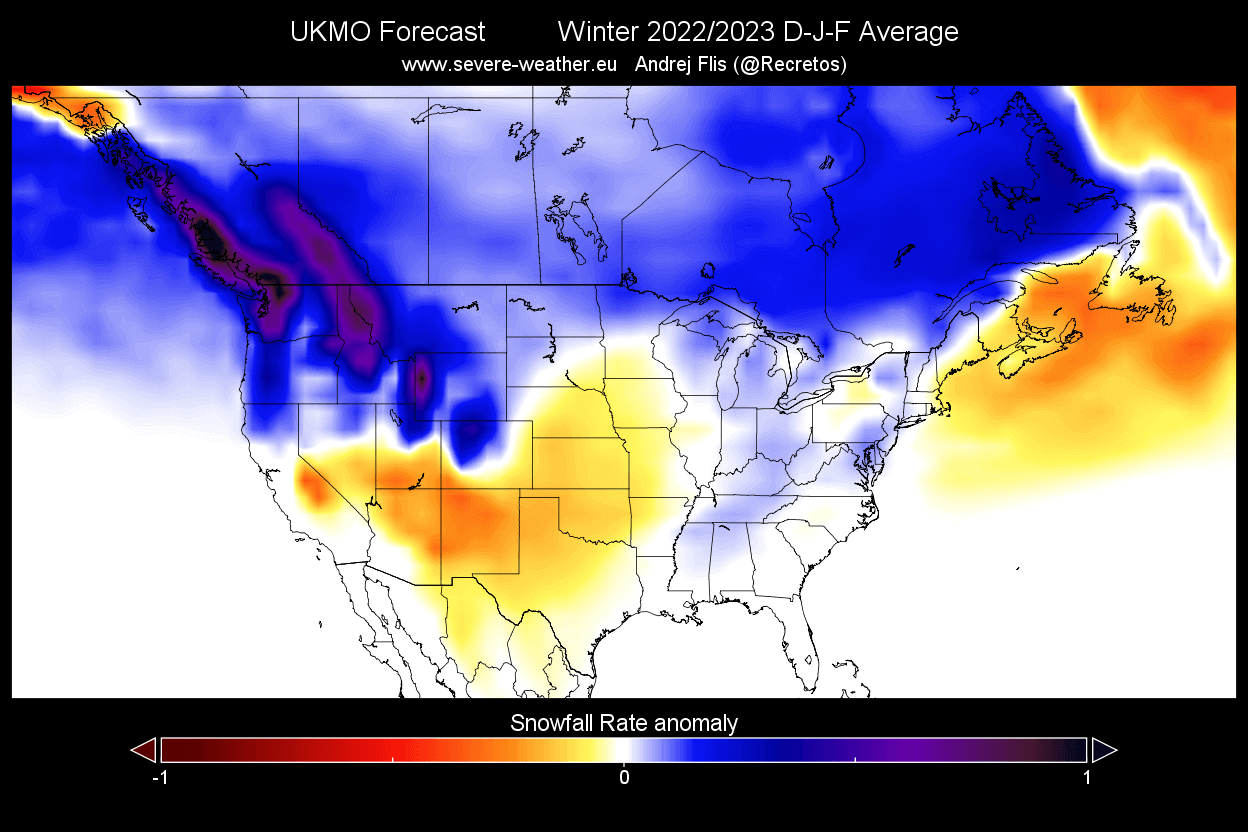
Looking at Canada, we see most of the southern half with above-normal snowfall over the seasonal Winter average.
The December snowfall forecast shows the snowfall increase over the northwestern United States. More snowfall is seen over parts of the far Midwest. The rest of the United States is forecast to receive less snowfall than normal this month, with the expectation of the Ohio river valley.
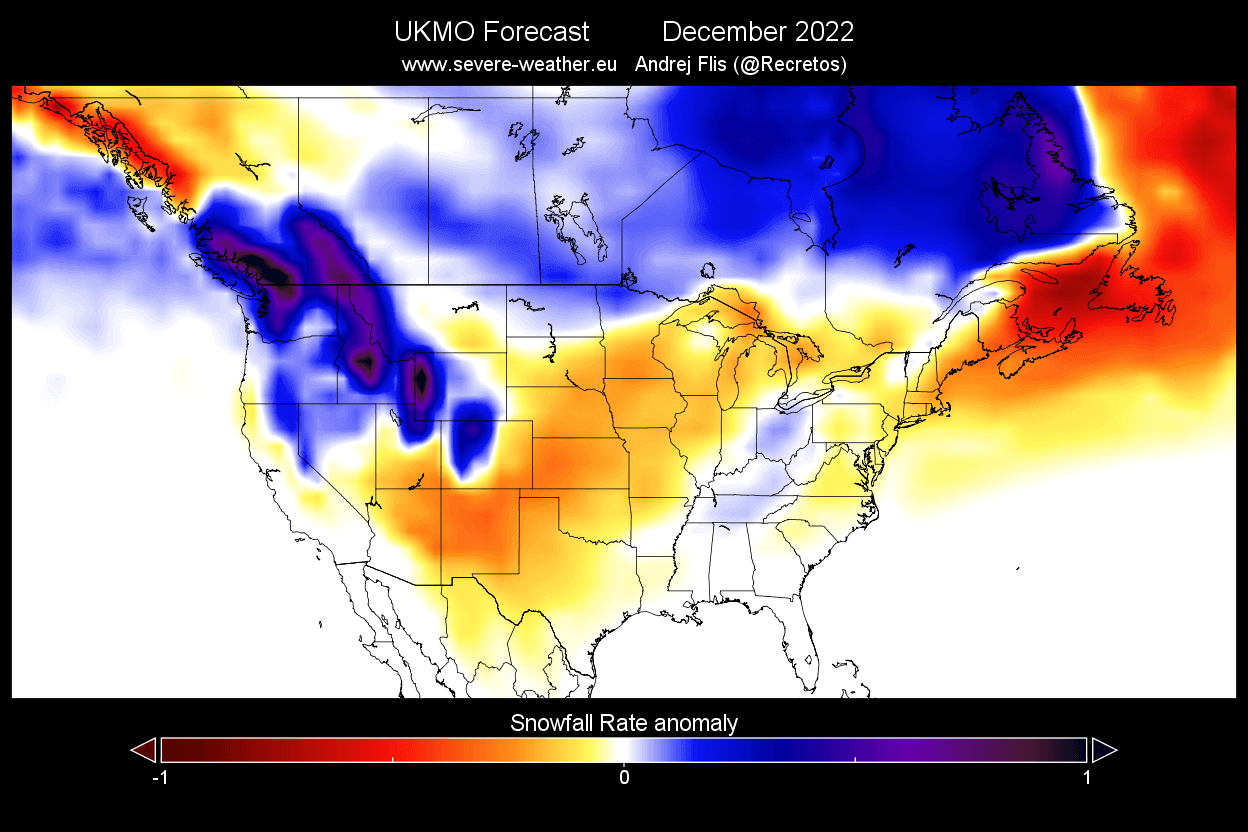
January snowfall forecast shows an even stronger pattern, with more snowfall over much of southern Canada and the northern half of the United States. This looks much closer to an expected snowfall pattern in a La Nina winter.
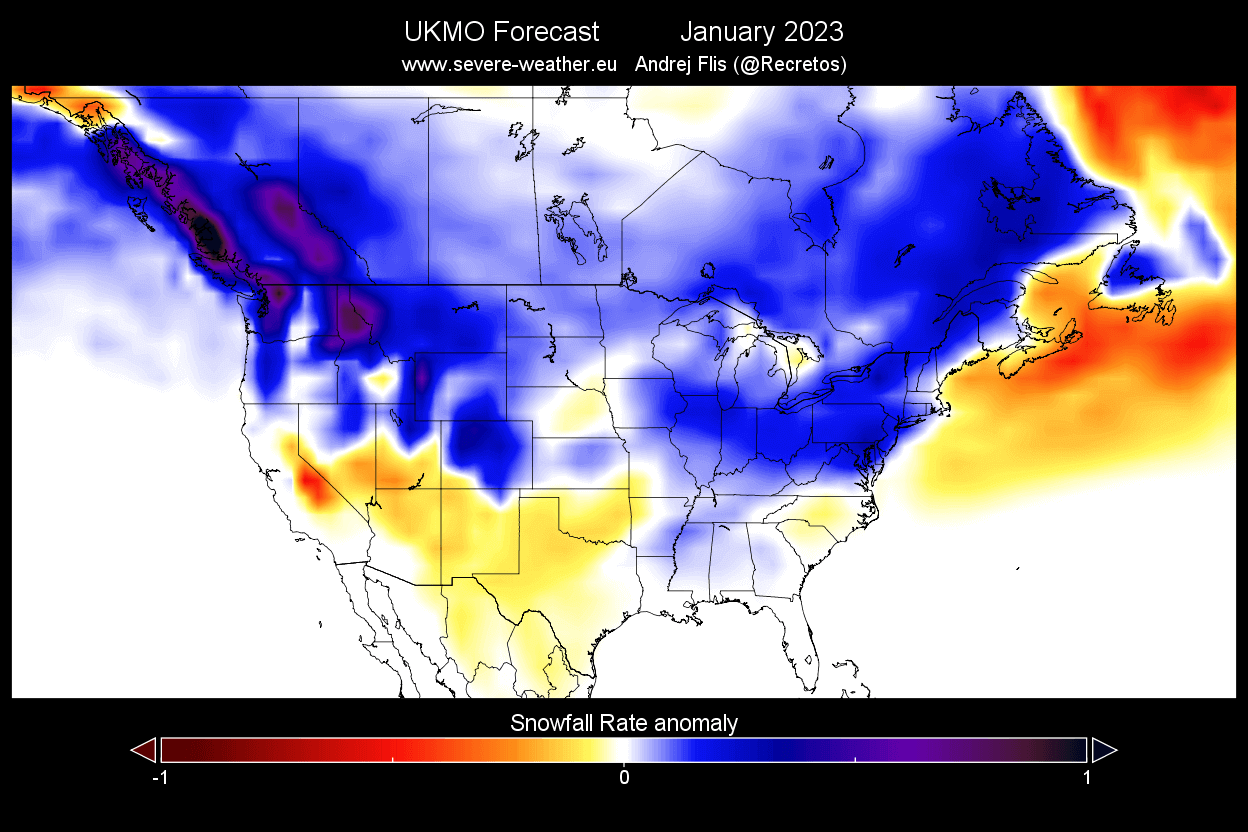
Apart from the southwestern United States, we can see more snowfall being also forecast over the eastern half of the country.
The February snowfall forecast shows snowfall potential backing off into the northern parts of the United States. This is mainly a result of warmer-than-normal temperatures expected in late Winter by UKMO. But we can still see an area of more snowfall potential in the Southeast.
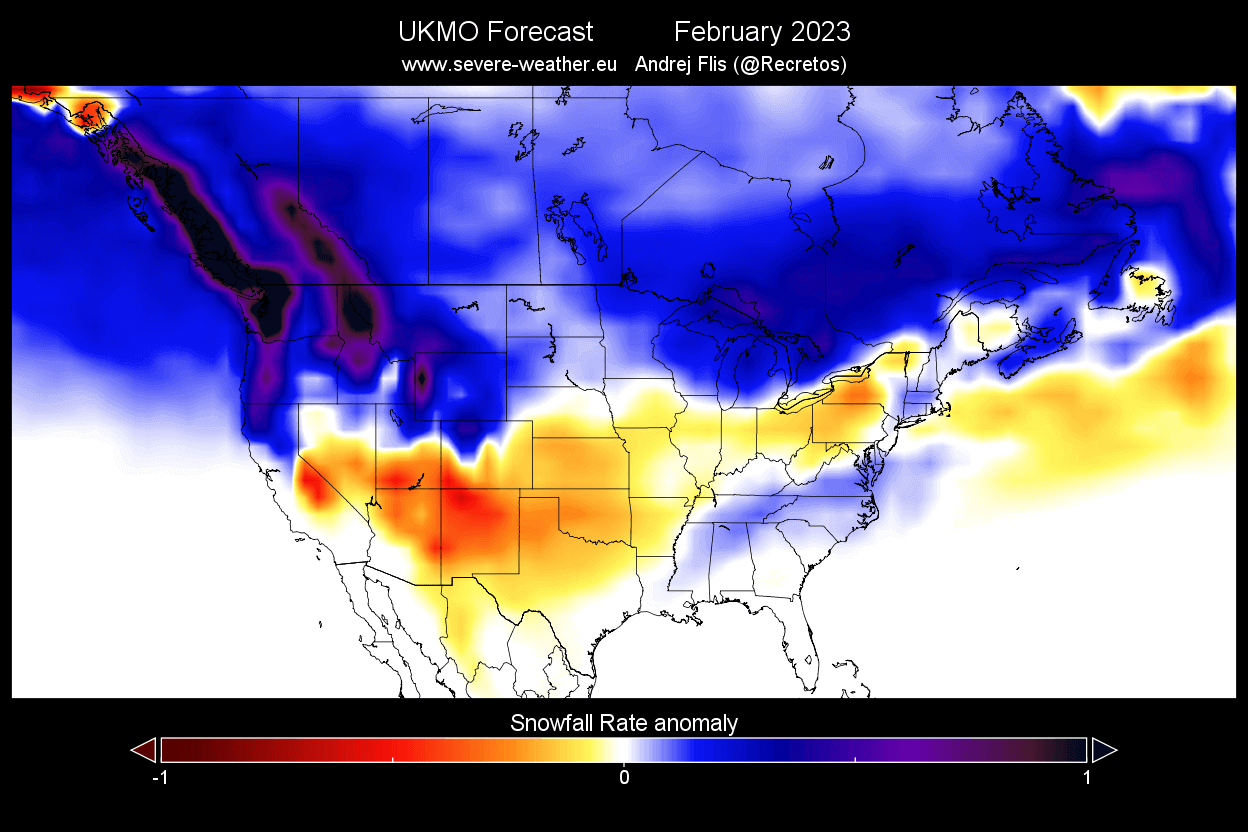
The southeastern United States snowfall is perhaps an unlikely scenario at first, but just one intense cold outbreak could bring some snowfall further far into the south.
We have also produced an image that shows the snowfall forecast change compared to the forecast from last month. This latest forecast cycle shows more snowfall over much of the northwestern United States. But surprisingly, it has increased the snow potential over the eastern United States.
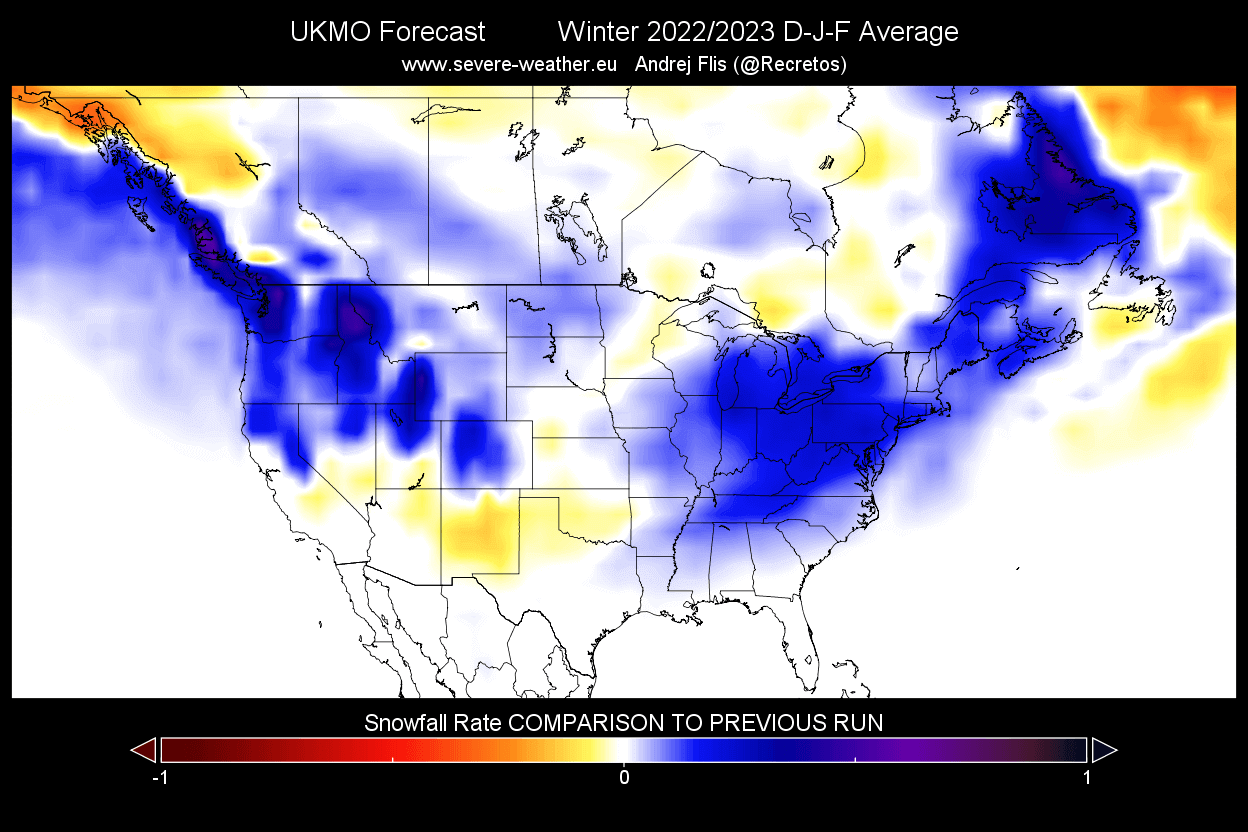
Finishing off with the March forecast, we can see a decent snow season continuing over most of the northern half of the United States. Some areas over the southern and eastern parts still show potential for more snowfall than average this month.
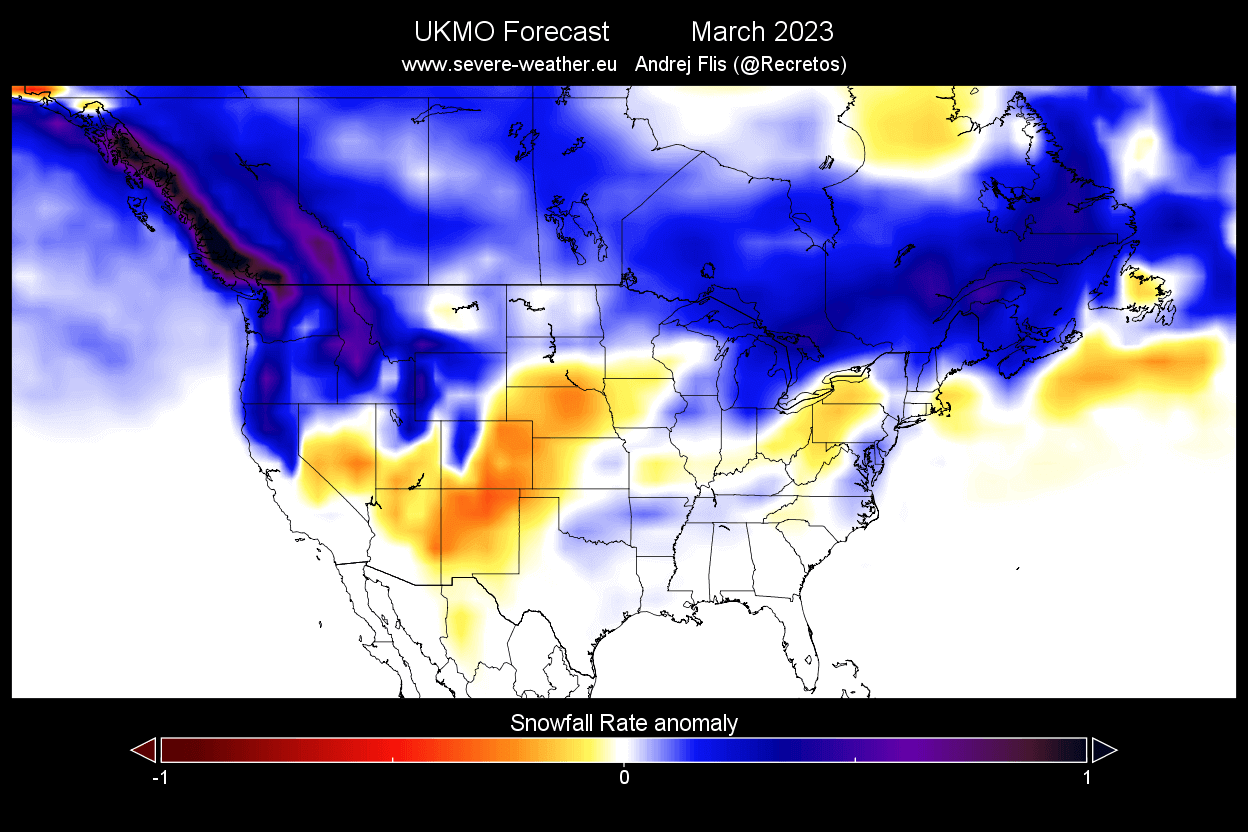
Overall, the UKMO shows a decent snow season across the northern United States. It also shows some snow scenarios over the eastern and southeastern United States.
NOAA OFFICIAL WINTER 2022/2023 FORECAST
We can also track snowfall potential on normal temperature and precipitation Winter forecasts. The highest snowfall potential is usually in regions with colder temperatures and more precipitation.
This is can be seen in the NOAA’s official Winter 2022/2023 temperature forecast for the United States. It shows colder temperature probabilities for most of the northern United States. The southern half of the country has a higher probability of warmer than normal weather.
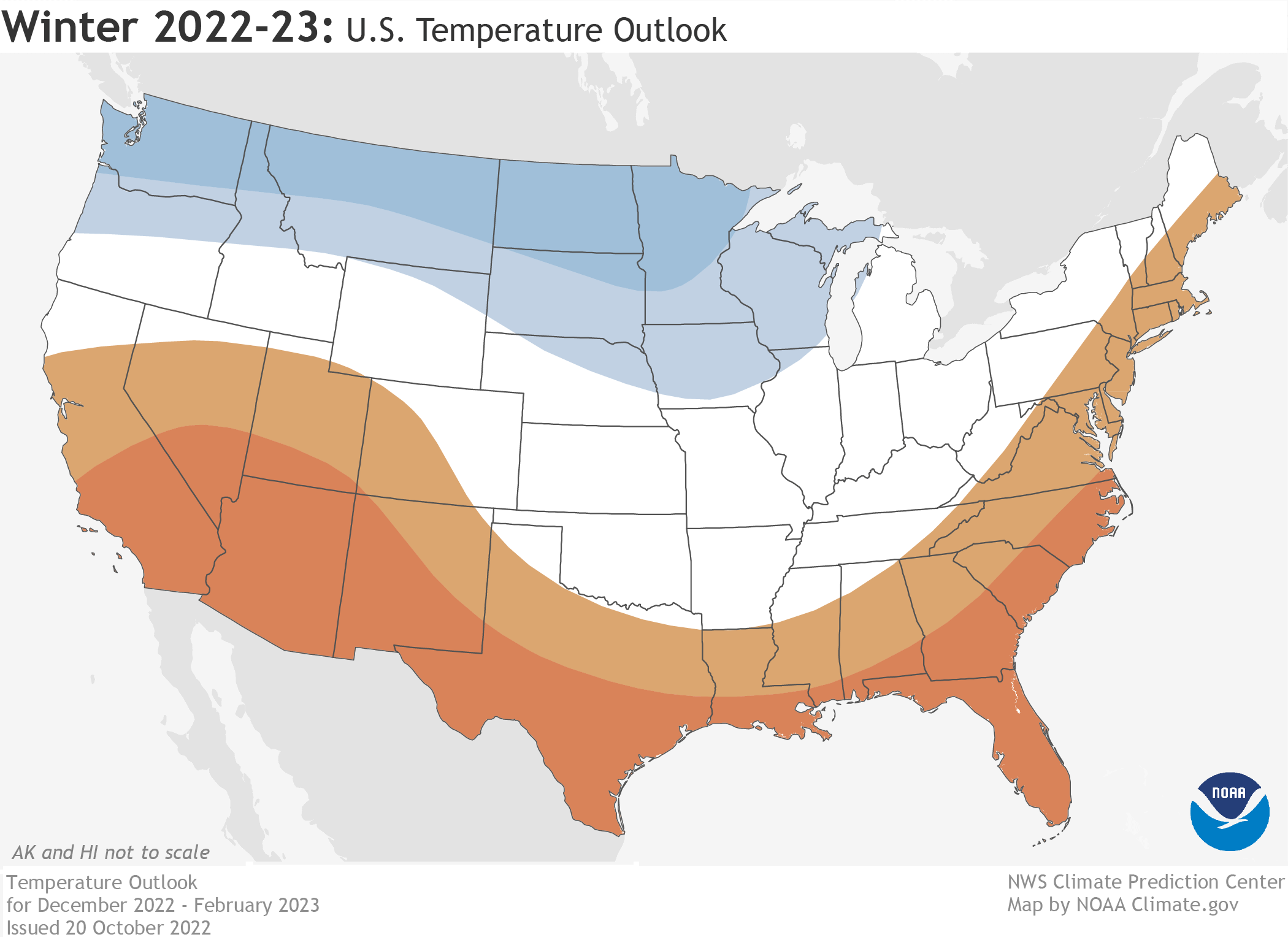
But take note of the trough of “average” temperatures probability extending into the south-central United States. That can be interpreted as a potential route of winter cold air outbreaks and can explain the increased snowfall potential down to the south and Southeast.
The official NOAA Temperature outlook points:
- The greatest chance for warmer-than-average conditions is in the Central Great Basin and Southwest extending through the Southern Plains.
- Warmer-than-average temperatures are also favored in the Southeastern U.S. and along the Atlantic coast.
- Below-normal temperatures are favored from the Pacific Northwest eastward to the western Great Lakes
The official precipitation forecast is similar to the UKMO and the historical data. We see an equal-to-higher probability for more precipitation (and snowfall) over the northern half of the United States. The southern United States is forecast to have a drier winter season, typical for a La Nina Winter.
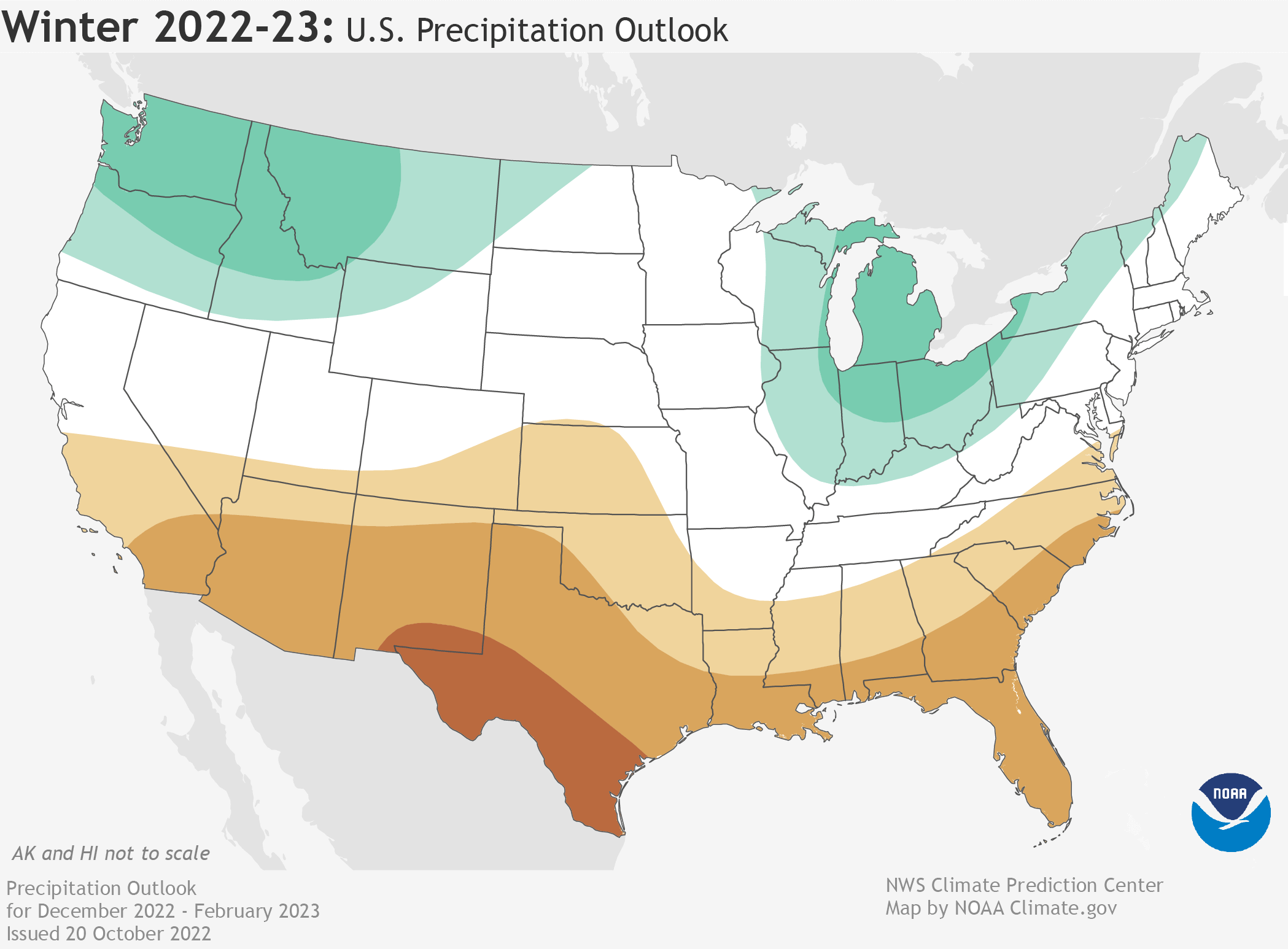
NOAA Official precipitation outlook points:
- Wetter-than-average conditions are most likely in the Pacific Northwest, the northern Rockies, Great Lakes, and Ohio Valley.
- The greatest chances for drier-than-average conditions are forecast in portions of California, the Southwest, the southern Rockies, the southern Plains, the Gulf Coast, and much of the Southeast.
Also, we will keep you updated on other developing weather trends, so bookmark our page. Also, if you have seen this article in the Google App (Discover) feed, click the like button (♥) there to see more of our forecasts and our latest articles on weather and nature in general.
Don’t miss: